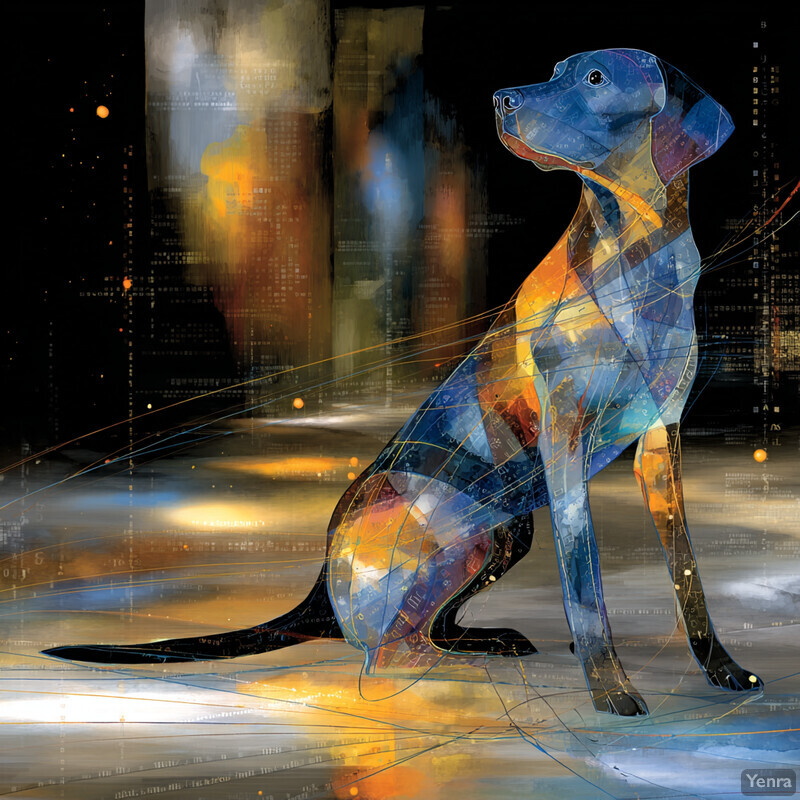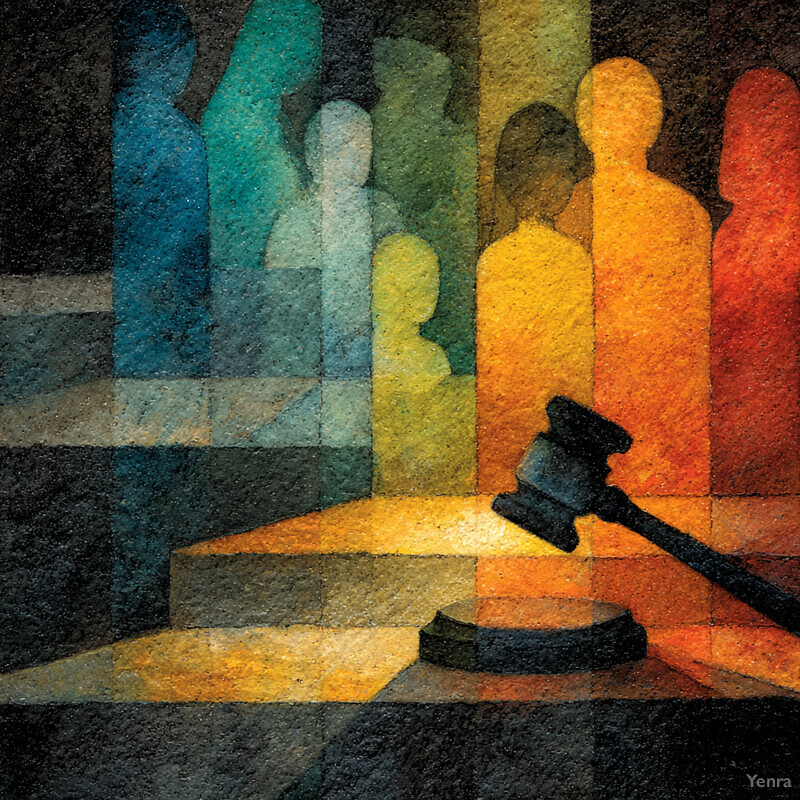Introduction
Imagine waking up to a gentle morning routine softly orchestrated by artificial intelligence (AI). Your alarm clock, powered by AI, adjusts itself to your sleep cycle, ensuring you feel rested. A smart coffee maker brews your favorite blend at just the right time. As you scan the morning news, an AI assistant has already filtered out misinformation and highlighted the stories that matter most to you. In this serene scenario, AI works quietly in the background – enhancing daily life in subtle, seamless ways. This isn’t science fiction or a privilege for tech experts; it’s an emerging reality for everyone. And it raises an important question: How do we ensure everyone can navigate an AI-driven world with confidence and understanding?
 Morning Symphony: In a softly lit kitchen
at dawn, a sleek AI-powered coffee maker emits gentle steam as it pours
a perfect cup, while a voice-activated alarm clock floats nearby, its
holographic display showing sleep-cycle data—ethereal light filtering
through gauzy curtains, giving the scene a dreamlike, poetic
glow.
Morning Symphony: In a softly lit kitchen
at dawn, a sleek AI-powered coffee maker emits gentle steam as it pours
a perfect cup, while a voice-activated alarm clock floats nearby, its
holographic display showing sleep-cycle data—ethereal light filtering
through gauzy curtains, giving the scene a dreamlike, poetic
glow.
AI is no longer confined to research labs or Silicon Valley startups. It’s woven into our jobs (from automated email filters to smart recruitment tools), our roles as citizens (like AI-curated social media feeds influencing public opinion), and even our peace of mind (for instance, AI wellness apps that help us meditate or manage stress). Developing AI literacy – the basic knowledge and skills to understand and work with AI – is becoming as essential as digital literacy. Just as basic computer skills became necessary over the past few decades, now “AI literacy is becoming fundamental to understanding and shaping our future”. In fact, governments and educators around the world are waking up to this need. California recently passed a law requiring AI literacy in schools, and the European Union’s new AI Act mandates AI-awareness programs for organizations deploying AI. “AI literacy is incredibly important right now,” says Stanford professor Victor Lee, “especially as we’re figuring out policies… People who know more … are able to direct things”, whereas a more AI-literate society can build “more societal consensus”. In short, understanding AI empowers us – it helps us stay employable in changing workplaces, engage as informed citizens on tech policy, and demystify the technology so it doesn’t feel like an uncontrollable magic. As one team of researchers put it, without widespread AI literacy, we risk “ceding important aspects of society’s future to a handful of multinational companies”. The good news is that AI literacy is not about advanced math or programming; it’s about grasping core concepts that anyone can learn.
 Digital Dawn Chorus: A serene bedroom
bathed in pastel sunrise hues, where a minimalist AI assistant hovers as
a translucent orb by the bedside, curating news headlines that
materialize as delicate, floating text ribbons—subtle reflections on
polished surfaces, evoking an otherworldly harmony between technology
and daily ritual.
Digital Dawn Chorus: A serene bedroom
bathed in pastel sunrise hues, where a minimalist AI assistant hovers as
a translucent orb by the bedside, curating news headlines that
materialize as delicate, floating text ribbons—subtle reflections on
polished surfaces, evoking an otherworldly harmony between technology
and daily ritual.
In this guide, we’ll journey through essential AI concepts in plain language, with inspiring examples of how human-centered AI is making the world better. By the end, you’ll see that AI literacy is for everyone – and that includes you. Whether you’re a parent, artist, teacher, healthcare worker, or retiree, you can absolutely gain the understanding needed to thrive alongside AI. Let’s begin by establishing a clear, jargon-free understanding of what AI actually is and how it works.
What Is AI?
Artificial Intelligence (AI) broadly refers to machines or software performing tasks that typically require human intelligence – things like learning, reasoning, creativity, and decision-making. AI isn’t a single gadget or a robot’s brain; it’s a field of computer science with many approaches. Let’s break down a few key terms you’ll hear, using everyday metaphors to keep things accessible:
 Pattern Playground: A sunlit study where
a child sits cross-legged on a colorful rug, surrounded by floating
holographic photos of cats and dogs, their eyes alight with curiosity as
gentle beams of light connect matching images—an ethereal classroom of
patterns and discovery.
Pattern Playground: A sunlit study where
a child sits cross-legged on a colorful rug, surrounded by floating
holographic photos of cats and dogs, their eyes alight with curiosity as
gentle beams of light connect matching images—an ethereal classroom of
patterns and discovery.
Machine Learning (ML): Imagine you’re teaching a child to differentiate between cats and dogs. Instead of giving the child a long list of rules (“dogs bark, cats meow, dogs have certain snout shapes”), you simply show them lots of pet photos and tell them which are cats and which are dogs. Eventually, the child learns the patterns and can guess correctly on new photos. That’s essentially how machine learning works – the computer “learns” from many examples rather than explicit programming. “Machine learning systems learn from data instead of following explicit rules. They use patterns found in large sets of information to make decisions.” In early AI (1950s–1980s), most systems were rule-based, meaning programmers manually coded explicit rules for every decision. Those systems were like very strict recipe-followers – they couldn’t handle anything unforeseen. Modern AI shifted to machine learning, where the system builds its own rules or models from data, making it far more adaptable. For example, your email’s spam filter isn’t using a fixed checklist from an engineer; it’s a machine learning model trained on millions of example emails. Over time it has “learned” the subtle features that distinguish spam from legitimate mail – a much more flexible approach than any static rulebook. (Indeed, AI spam filters today continually improve by spotting new patterns in unwanted emails, a task that would overwhelm hard-coded rules.)
 Neural Nexus: Inside a vast, dimly lit hall of
softly glowing filaments, countless luminescent nodes pulse in layered
tiers like a delicate spider’s web, each connection shimmering as
signals flow through the neural network’s labyrinthine pathways—a poetic
dance of emerging intelligence.
Neural Nexus: Inside a vast, dimly lit hall of
softly glowing filaments, countless luminescent nodes pulse in layered
tiers like a delicate spider’s web, each connection shimmering as
signals flow through the neural network’s labyrinthine pathways—a poetic
dance of emerging intelligence.
Neural Networks: This term sounds like a brain, and in a very loose way, it is inspired by brains. If machine learning is the concept of learning from examples, neural networks are one popular technique to do so. A neural network is essentially a layered system of mathematical functions (“neurons”) that adjust their connections (weights) during training. It’s reminiscent of an enormous web of decision-makers passing signals around, gradually tuning themselves to get the right answer – much like neurons firing in a brain, though far simpler. You can think of a neural network as a team of experts: the first layer might detect simple shapes or features in an image, the next layer builds on those (detecting combinations of features), and deeper layers assemble high-level recognitions (like “aha, these features together look like a face!”). During training, the network adjusts the importance of each connection to improve its accuracy. By the end, it becomes very skilled at mapping input data (say, an image) to an output (say, “cat” or “dog”). Modern AI breakthroughs largely stem from deep learning, which just means neural networks with many layers (“deep” refers to depth in layers). As OpenAI’s CEO Sam Altman succinctly put it: “In three words: deep learning worked.” After decades of research, around the 2010s we finally had enough data and computing power for neural networks to shine. They began outperforming older AI methods and revolutionized fields like vision and speech. This shift – from manually coded rules to machine-learned neural network models – is the brief historical journey of AI. Early AI could follow instructions but not learn; today’s AI learns from experience, which is a game-changer.
 Imaginative Alchemy: In a warm, rustic
kitchen at dusk, a masterful AI “chef” stirs a glowing cauldron of
digital ingredients—scrolls of text, fragments of melody, and
brushstrokes of color—melding them into a brand-new creation as floating
symbols swirl overhead, evoking the magic of generative AI.
Imaginative Alchemy: In a warm, rustic
kitchen at dusk, a masterful AI “chef” stirs a glowing cauldron of
digital ingredients—scrolls of text, fragments of melody, and
brushstrokes of color—melding them into a brand-new creation as floating
symbols swirl overhead, evoking the magic of generative AI.
Generative AI: If you’ve heard of ChatGPT, Midjourney, Suno, or other AI tools that create things (like text, images, music, etc.), you’re talking about generative AI. A simple way to grasp generative AI is to think of a knowledgeable chef who has tasted thousands of dishes and can now improvise a new recipe that “fits” with what they know. Generative AI models are trained on huge amounts of data (text, images, audio) and learn the underlying patterns of that data. Then they can generate new content that follows those patterns. For instance, GPT-4 (a generative language model) was trained on a vast swath of internet text and can now produce paragraphs that read remarkably like something a human might write. As MIT researchers explain, “Generative AI can be thought of as a machine-learning model trained to create new data, rather than just make a prediction. It learns to generate more objects that look like the data it was trained on.” So, given prompts, a generative AI might write a short story in the style of Jane Austen or conjure a photorealistic image of a sunset over Mars. This branch of AI has existed in simpler forms for decades, but around 2022 it truly exploded into public awareness because the outputs (like human-quality text and artwork) became astonishingly good. Generative models use advanced neural network architectures – for example, transformers for language, or diffusion models for images – but as a user you don’t need to know those details. The key point: generative AI is like a super-creative parrot – it doesn’t think like a human, but it remix-and-produces content based on patterns it observed. This unlocks incredible tools for aiding human creativity (as we’ll see later), while also raising new questions about authenticity (deepfake images or AI-written essays).
 Linguistic Loom: A moonlit library with
towering shelves of ancient tomes, where a graceful automaton weaves
threads of glowing script between quills and scrolls, crafting seamless
sentences in midair—an enchanting tapestry of language spun by the art
of NLP.
Linguistic Loom: A moonlit library with
towering shelves of ancient tomes, where a graceful automaton weaves
threads of glowing script between quills and scrolls, crafting seamless
sentences in midair—an enchanting tapestry of language spun by the art
of NLP.
Natural Language Processing (NLP): This is a subset of AI focused on enabling computers to understand and generate human language. Language is our most natural interface, so NLP is hugely important for AI’s interaction with us. You encounter NLP every day: when you use a voice assistant (Alexa, Siri, Google Assistant), when you see machine-translated text, or when your phone’s autocomplete finishes your sentences. In simple terms, “NLP is a subfield of AI that uses machine learning to enable computers to understand and communicate with human language.” Through NLP techniques, AI systems can recognize speech, interpret the meaning of text, converse in chatbots, summarize documents, and more. A helpful metaphor: think of NLP as teaching a computer to become a really good foreign language student. The computer doesn’t natively know English or Chinese – it reads lots of examples and learns how words relate, how grammar works, and what context implies. Early NLP relied on hand-crafted grammar rules, but modern NLP mostly uses learning methods (like those big neural network models that predict text). The result is AI that can engage in dialogue (albeit with no genuine understanding or intent behind its words – it’s mimicking understanding by statistical prediction). Today’s most advanced NLP systems are the large language models (LLMs) like GPT, which can produce remarkably coherent and context-aware text. They’re not perfect – they often make errors or nonsensical statements (as we’ll discuss) – but they show how far AI has come in handling the nuance of human language.
In summary, AI is an umbrella term and within it, machine learning (especially deep learning with neural networks) has been the engine driving recent progress. We now have AI that can learn from data rather than rigidly follow pre-written rules – which is why AI feels so much more powerful and adaptable than the software of old. In the next section, we’ll demystify how these AI systems actually learn and make decisions. If you’ve ever wondered “What’s going on inside the black box?”, read on – we’ll explain it in plain English with concrete examples. ## How AI Learns and Makes Decisions
We often hear phrases like “trained on data” or “the AI predicts X”, but what does that process actually look like? Let’s pull back the curtain on how an AI model goes from training to making decisions (a process known as inference). You don’t need a PhD to grasp the intuition:
 Endless Practice: In a luminous atelier
filled with translucent data scrolls and floating quiz cards, a graceful
apprentice AI pores over each card under soft golden light—lines of code
and whispered labels drifting like motes—symbolizing diligent learning
from countless examples.
Endless Practice: In a luminous atelier
filled with translucent data scrolls and floating quiz cards, a graceful
apprentice AI pores over each card under soft golden light—lines of code
and whispered labels drifting like motes—symbolizing diligent learning
from countless examples.
Training Phase – Learning from Data: Think of this as the “studying” period for the AI. The developers compile a training dataset – examples relevant to the task. For instance, to train an email spam filter, they might collect millions of emails labeled “spam” or “not spam.” To train an image recognizer, they gather photos with labels of what’s in them. The AI model then learns from these examples. How? If it’s a neural network, learning means adjusting all those internal connections to better map inputs to correct outputs. In each round, the model makes a guess on some training examples, the training algorithm checks the guess against the true answers, and then nudges the model’s parameters to reduce errors. It’s akin to how a student might do practice quiz questions and adjust their approach based on which answers were wrong. Over many iterations (sometimes billions of them!), the AI model gradually improves. It generalizes patterns from the training data. For example, a spam filter might learn that emails containing phrases like “free money!!!” and a lot of exclamation points tend to be spam, or that messages from certain senders who you’ve marked as safe are not spam. A photo-tagging AI might learn what your friend Alice’s face looks like by analyzing pixel patterns across many tagged photos of Alice. One common worry is that AI models are a complete “black box,” meaning we can’t understand how they make decisions. It’s true that models like deep neural networks are complex and not easily interpretable line-by-line. However, they’re not magic – they’re still following mathematical patterns gleaned from data. Researchers are actively developing explainable AI tools to shine light on these black boxes (for instance, highlighting which words in an email led the spam filter to flag it). And practically speaking, even if we don’t see every gear turning inside the model, we can evaluate its performance and behavior thoroughly. In training, developers test the AI on separate validation data to see if it’s learning correctly and not, say, memorizing weird quirks (overfitting). This is similar to giving a student a practice test on new questions to ensure they truly learned the material, not just the exact flashcards they studied.
 Tapestry of Knowledge: A vast
celestial loom where shimmering threads of email snippets and pixelated
images weave together into a radiant fabric; at its heart, a delicate
spindle adjusts patterns with each pass, evoking the iterative training
process refining an AI’s understanding.
Tapestry of Knowledge: A vast
celestial loom where shimmering threads of email snippets and pixelated
images weave together into a radiant fabric; at its heart, a delicate
spindle adjusts patterns with each pass, evoking the iterative training
process refining an AI’s understanding.
Inference Phase – Making Decisions or Predictions: Once trained, the AI model is deployed to do its job “for real.” Now it receives new inputs it’s never seen before and must make an informed prediction or decision based on what it learned. This stage is called inference. For our examples: when a new email arrives in your inbox, the spam filter model quickly computes a spam score for it – essentially, “how similar is this email to the spam I saw in training?” If the score is high, it classifies the email as spam (perhaps shuttling it to your spam folder); if low, it lets it through. What’s neat is that the model can pay attention to dozens or even hundreds of factors at once: the sender’s reputation, certain keywords, the email’s formatting, all weighted according to its training. (One can imagine it as a very diligent guard dog that has sniffed thousands of intruders and visitors – it’s developed a nose for suspicious vs. friendly behavior in email content.) In the case of a photo-tagging system like those on Facebook or Google Photos, when you upload a new picture, the AI analyzes the image’s features and compares them to the “memory” of each person’s face it learned during training. If the pattern of pixels matches Alice’s known pattern with high confidence, the system suggests tagging Alice in the photo. Facebook’s now-retired face recognition system, for instance, could “provide recommendations for who to tag in photos” by using a trained model to match faces. That model was so advanced it even powered accessibility features – it could tell a visually impaired user “when they or one of their friends is in an image” via automatic photo descriptions. This shows how AI’s pattern recognition, once trained, can be applied to benefit people in real-time scenarios.
 Digital Sentinels: A luminous data-stream
guard dog fashioned from cascading email icons and glowing code fibers
stands alert at a shimmering threshold, its sensor-nose discerning
threats as incoming envelopes trace trails of light and are guided into
separate, ethereal pathways.
Digital Sentinels: A luminous data-stream
guard dog fashioned from cascading email icons and glowing code fibers
stands alert at a shimmering threshold, its sensor-nose discerning
threats as incoming envelopes trace trails of light and are guided into
separate, ethereal pathways.
To illustrate AI decision-making with a concrete mental image, consider how a spam filter using a certain ML technique (called Support Vector Machine) was described by one author: “imagine two fields, one with cows and one with sheep. The job of the AI is to create a fence that separates them”. In other words, the algorithm finds the boundary that best divides spam vs. not-spam in the multi-dimensional space of email features. During inference, it’s as if each new email is a new animal – the model checks which side of the fence it falls on (spam side or not-spam side). Through training, the AI has “figured out the characteristics of the cows (legitimate emails) and sheep (spam) so it can keep them apart.” And with modern deep learning, these “characteristics” can be incredibly subtle – combinations of words, sender metadata, etc. – that humans alone might miss.
 Boundary of Light: In a twilight meadow
of floating pixel-patterns, iridescent cows and sheep graze side by
side, while a delicate, neon-lined fence emerges—splitting the field
into two realms—symbolizing the AI’s decision boundary as new data
points wander into their destined domains.
Boundary of Light: In a twilight meadow
of floating pixel-patterns, iridescent cows and sheep graze side by
side, while a delicate, neon-lined fence emerges—splitting the field
into two realms—symbolizing the AI’s decision boundary as new data
points wander into their destined domains.
It’s important to note that AI models do not “think” or “understand” the way humans do. They don’t truly comprehend meaning; they simply correlate patterns with outcomes. The spam filter isn’t aware of what “winning a free iPhone” means, it has just statistically learned that phrase often coincides with unwanted emails. Likewise, an AI medical diagnosis system that learned from patient data might predict a disease, but it doesn’t feel concern or know what the patient is experiencing. It’s crunching patterns. This pattern-matching nature is why AI can sometimes be fooled or make odd mistakes – it has no common sense beyond its data. A famous example: an image recognition AI once misidentified a picture of a panda as a gibbon after imperceptible noise was added to the image – because the noise tricked the pattern detector in ways a human never would be tricked. We’ll talk more about such limitations and myths (like the idea of AI being infallible or “too smart”) in a later section.
For now, the key takeaway is that AI learns by example and makes decisions by analogy. It’s like a student turned specialist: it studied hard on training data, formed its own internal knowledge representations, and now applies that knowledge to new situations. When designed and trained well, AI systems can achieve remarkable accuracy and efficiency in their domains – sometimes even surpassing human performance in narrowly defined tasks (for instance, identifying certain patterns in medical images or finding anomalies in financial transactions). But when designed or trained poorly, or asked to operate outside their expertise, they can also produce laughable or dangerous errors. This is why understanding how AI learns isn’t just academically interesting – it directly impacts how much we should trust a given AI system and how we should use it. We’ll delve into trust and ethics soon, but first, let’s look at AI’s positive impact by surveying some real-world applications across different fields. ## AI in the Real World
AI may sound abstract, but its real-world applications are concrete and often life-changing. Let’s explore a few uplifting case studies in healthcare, education, finance, and creative arts – areas that affect us all. These examples highlight AI’s human-centered potential: rather than replacing people, AI is augmenting human efforts to achieve better outcomes.
In hospitals and clinics, AI has quietly become a powerful ally to doctors and patients. One striking example is in breast cancer screening. Reading mammograms (breast X-rays) is a tough task even for experienced radiologists – cancers can be subtle, and human fatigue or oversight can miss early signs. ### Healthcare: Saving Lives and Advancing Medicine
 Radiant Vigilance: In a softly lit
hospital imaging suite, a glowing AI-enhanced mammogram display
illuminates subtle breast tissue patterns with delicate highlight
overlays, while a focused radiologist stands nearby—melding human
compassion and digital precision in an ethereal dance of care.
Radiant Vigilance: In a softly lit
hospital imaging suite, a glowing AI-enhanced mammogram display
illuminates subtle breast tissue patterns with delicate highlight
overlays, while a focused radiologist stands nearby—melding human
compassion and digital precision in an ethereal dance of care.
Enter AI: researchers in Sweden conducted a large trial with over 100,000 women to see if AI could help in screening. The results? Combining AI with radiologist review significantly boosted detection of cancers while reducing doctors’ workload. AI-supported screening found 29% more cancers than traditional methods, including 24% more early-stage invasive cancers that are crucial to catch early. Importantly, this didn’t flood patients with false alarms – false positives only rose by about 1%. Kristina Lång, the radiologist leading the trial, noted the AI even caught “relatively more aggressive cancers that are particularly important to detect early”, which could mean saved lives through timely treatment. Essentially, the AI serves as a tireless second pair of eyes, scanning images quickly and flagging anything suspicious. Radiologists then focus their expertise where it’s needed most. This kind of human-AI teaming is a glimpse of medicine’s future – one where AI handles the grunt work of analysis, freeing doctors to spend more time with patients or on complex decision-making. Beyond imaging, AI is accelerating drug discovery (identifying new molecules for medications in a fraction of the traditional time) and predicting patient outcomes (allowing preventive care). During the COVID-19 pandemic, AI models helped epidemiologists predict outbreak hotspots and triage patients based on risk. And in a famous scientific milestone, DeepMind’s AlphaFold AI solved the 50-year-old grand challenge of predicting protein structures – a breakthrough that can speed up designing cures and understanding diseases. In just a couple of years, AlphaFold predicted 200 million protein structures (virtually every protein known to science), “potentially saving millions of dollars and hundreds of millions of years in research time.” This kind of behind-the-scenes AI isn’t visible to most, but it’s poised to lead to new vaccines, treatments, and medical marvels that benefit everyone.
 Celestial Proteome: Against a twilight
laboratory backdrop, iridescent ribbons of protein structures float like
cosmic origami, guided by an AI-generated neural lattice—capturing the
poetic beauty of molecular revelation and algorithmic insight.
Celestial Proteome: Against a twilight
laboratory backdrop, iridescent ribbons of protein structures float like
cosmic origami, guided by an AI-generated neural lattice—capturing the
poetic beauty of molecular revelation and algorithmic insight.
Education: Personal Tutors for Every Student
If you’ve ever struggled in a large class or needed extra help on homework, you’ll appreciate how AI is making education more personalized and accessible. AI tutoring systems have advanced to the point that they can mimic some of the interactive guidance of a human tutor – and crucially, they can do it at scale. A leading example is Khan Academy’s Khanmigo, an AI-powered tutor built on top of a state-of-the-art language model (GPT-4). Instead of simply giving students answers, Khanmigo engages them in dialogue, asking Socratic questions to nudge their thinking. “It’s like a virtual Socrates, guiding students through their educational journey,” says Khan Academy founder Sal Khan. For instance, if a student is stuck on an algebra problem, Khanmigo might ask them to explain what the problem is asking, then suggest a first step rather than just solving it outright. It adapts to each student’s pace – providing hints if needed, or offering harder follow-up questions if the student is breezing through.
 Virtual Socrates: In a luminous,
book-lined study bathed in dawn’s pastel glow, a holographic tutor with
gentle, animated expressions guides a curious student through floating
algebraic symbols—soft beams of light tracing Socratic questions in the
air as knowledge blossoms between them.
Virtual Socrates: In a luminous,
book-lined study bathed in dawn’s pastel glow, a holographic tutor with
gentle, animated expressions guides a curious student through floating
algebraic symbols—soft beams of light tracing Socratic questions in the
air as knowledge blossoms between them.
Early pilots have reported enthusiastic responses from students and teachers alike. In one demonstration, school administrators witnessing AI tutoring in action said, “This aligns with our vision of creating thinkers.” The promise here is equity: not every child can have a 1-on-1 human tutor, but an AI tutor (carefully designed with pedagogical best practices) can be available to every child, anytime, for far less cost. This could help bridge learning gaps, giving under-resourced schools access to high-quality assistance. Teachers aren’t left out, either – AI can handle tedious tasks like grading quizzes or drafting lesson plans, which saves educators time for more creative and interpersonal aspects of teaching. Of course, AI in education must be used thoughtfully (it can make mistakes in answers, and it lacks the emotional intelligence of humans), but with proper integration, it’s more like a teaching assistant than a teacher replacement. Imagine a classroom where each student who raises their hand for help can immediately get guided support, or where AI frees teachers from administrative burdens so they can mentor students individually. That’s increasingly becoming reality. On a larger scale, whole countries are pushing AI literacy through online courses – Finland’s Elements of AI course, for example, has introduced over one million people from 170+ countries to AI basics for free, often in their native languages. This democratization of knowledge through AI and about AI creates a virtuous cycle: an educated population can leverage AI better, which in turn improves education and society.
 Aurora Classroom: A modern classroom
suffused with ethereal light, where each student’s desk is crowned by a
translucent AI tutor—delicate threads of glowing code weave between
pupil and guide, lifting homework problems into the air like
constellations to be explored together.
Aurora Classroom: A modern classroom
suffused with ethereal light, where each student’s desk is crowned by a
translucent AI tutor—delicate threads of glowing code weave between
pupil and guide, lifting homework problems into the air like
constellations to be explored together.
Finance: Inclusion and Security Through AI
The finance industry has long used automation, but AI has supercharged its capabilities – bringing benefits especially in fraud prevention and financial inclusion. Let’s start with fraud detection, something that protects consumers and banks alike. If you’ve ever gotten an alert about a suspicious charge on your credit card, that was likely flagged by an AI system.
 Digital Sentinel: A neon-drenched
cityscape at midnight with glowing transaction paths arcing between
skyscrapers, where a translucent, ethereal AI guard dog silhouette
sniffs out anomalies among floating credit card icons—data streams
shimmering like aurora in the sky.
Digital Sentinel: A neon-drenched
cityscape at midnight with glowing transaction paths arcing between
skyscrapers, where a translucent, ethereal AI guard dog silhouette
sniffs out anomalies among floating credit card icons—data streams
shimmering like aurora in the sky.
These systems analyze millions of transactions and learn to spot anomalies in real time – patterns that suggest a transaction might be unauthorized. For example, if your card is suddenly used in a foreign country or a far-off city half an hour after it was used in your hometown, an AI might raise an eyebrow (so to speak). Modern fraud-detection AI looks at a plethora of factors (merchant, amount, user history, location, time, etc.) and has learned subtle correlations that often betray fraudsters. The result: billions of dollars saved by stopping fraudulent transactions, and consumers saved from headache and loss. Because the AI continuously learns from new fraud attempts, it keeps up with evolving tactics of criminals in a way hard-coded systems couldn’t. Now, on the financial inclusion front, AI is breaking down barriers that left billions without access to banking or credit. Traditional credit scoring (the kind that might approve or deny a loan) relies on formal credit history – which many people in developing regions or marginalized communities simply don’t have. AI offers a smart alternative: “AI-powered models, using alternative data sources, facilitate credit to groups that had limited or no access in the past.” Companies have developed algorithms that evaluate things like mobile phone usage patterns, utility bill payments, or even social network data to gauge an individual’s reliability for lending. For instance, one fintech called Tala analyzes how you use your phone – such as whether you regularly top-up your prepaid phone plan and how promptly you pay your utility bills – to generate a credit score. “Call and SMS records… serve as a means of determining an individual’s potential credit reliability,” allowing loans for those with no formal credit history. This has enabled micro-loans for small entrepreneurs in places like Kenya, India, and the Philippines, where tens of thousands of borrowers (often previously “unbankable”) have gotten loans through AI-driven risk models. As long as privacy is respected and bias is managed (topics we’ll revisit in Ethics), this use of AI can empower people economically.
 Inclusive Ledger: At dawn’s first light,
diverse hands from around the world hold smartphones projecting
holographic credit scores and utility symbols, connected by delicate
glowing threads that weave a radiant tapestry of AI-driven financial
inclusion and opportunity.
Inclusive Ledger: At dawn’s first light,
diverse hands from around the world hold smartphones projecting
holographic credit scores and utility symbols, connected by delicate
glowing threads that weave a radiant tapestry of AI-driven financial
inclusion and opportunity.
Meanwhile, mainstream banks use AI for everything from chatbots that answer customer questions (improving service access) to algorithmic trading that can improve returns for investors. The bottom line (pun intended) is that AI’s knack for pattern recognition and prediction is making financial systems more efficient, inclusive, and secure. The World Economic Forum even predicts that AI will lead to a net increase in jobs in the financial sector by creating new roles in fintech, data analysis, and AI oversight, compensating for those it automates. So rather than a dystopian take of AI wreaking havoc on finance, the emerging reality is AI helping more people participate in the financial system and shielding our money from bad actors. ### Creative Arts: Inspiring New Forms of Expression
One of the most exciting and surprising arenas for AI is in the creative arts. It turns out that algorithms can be creative partners – not replacing human artists, but collaborating in novel ways. In 2021, an AI system made headlines by helping complete Beethoven’s unfinished 10th Symphony – a project many thought impossible. Beethoven left only fragments of the 10th Symphony before he died. A team of musicologists and AI researchers trained an AI on all of Beethoven’s works and his style, then used it to suggest ways to develop those fragments. “We taught a machine both Beethoven’s entire body of work and his creative process,” explained Professor Ahmed Elgammal, who led the AI side of the project. The AI generated multiple possibilities for how Beethoven might have continued a melody or transitioned to a new theme, and the human composers on the team curated and wove those into a cohesive piece.
 Symphony Reimagined: In a hushed,
candlelit concert hall draped in crimson velvet, spectral notes swirl
like luminescent ribbons around an antique piano, while a translucent AI
muse in gentle ivory robes offers shimmering tendrils of melody to a
focused composer’s quill—melding Beethoven’s spirit with algorithmic
inspiration in an ethereal duet.
Symphony Reimagined: In a hushed,
candlelit concert hall draped in crimson velvet, spectral notes swirl
like luminescent ribbons around an antique piano, while a translucent AI
muse in gentle ivory robes offers shimmering tendrils of melody to a
focused composer’s quill—melding Beethoven’s spirit with algorithmic
inspiration in an ethereal duet.
The resulting symphony – a mix of Beethoven’s notes, AI suggestions, and human musicality – premiered in Bonn, Germany, to an audience both excited and astounded. This wasn’t a push-button miracle; it was two years of hard work between people and AI. But it showcased collaborative creativity: the AI could sift through countless musical ideas in Beethoven’s style (something no human could do alone so quickly), while humans applied taste and judgment to choose the best ones. Moving from classical music to visual art and film, AI tools are giving individual creators superpowers. Platforms like RunwayML provide no-code AI tools for artists, letting them do things like generate images from text descriptions, swap backgrounds in videos, or animate still photos – all without needing a Hollywood studio. “RunwayML allows machine learning techniques to be accessible to students and creative practitioners. Its excellent visual interface makes it easy to train your models… supporting text, image generation, and even motion capture.” Using such tools, a small team of indie filmmakers can create special effects that would’ve been prohibitively expensive before, or a painter can prototype variations of a concept by having the AI generate suggestions, which they then refine by hand. We’ve also seen AI-designed visual art fetch high prices at auctions, and AI-written poetry collections published. The important thing to note is that art is deeply human – AI doesn’t change that. Rather, AI expands the palette of what artists can do. As one artist put it, using AI is like “getting a new color of paint that was never available before.” We also see AI enabling participatory creativity: for example, the musician Grimes offered her AI-generated voice model to fans, allowing them to create new songs with her “AI voice” and even share royalties. And in design and architecture, AI can quickly generate dozens of prototype layouts or structures based on constraints, sparking human designers’ imagination and saving time on grunt work. In all these cases, the ethos is AI as a tool for humans to express themselves in new ways. It lowers technical barriers (you don’t need to know Maya or complex software to do certain effects now) and sometimes brings in element of surprise that can inspire. There are valid debates about authorship and originality when AI is involved – a topic beyond our scope here – but many creators are optimistic. They see AI as an “idea generator” or an assistant that can help overcome creative blocks
 Palette of Possibility: In a
sun-dappled artist’s loft with floor-to-ceiling windows, a painter
stands before a vast canvas that blooms with swirling fractal patterns
and photorealistic blossoms as an AI-driven projector casts delicate
motifs—brush and code intertwined in a dance of creative collaboration
under soft, golden light.
Palette of Possibility: In a
sun-dappled artist’s loft with floor-to-ceiling windows, a painter
stands before a vast canvas that blooms with swirling fractal patterns
and photorealistic blossoms as an AI-driven projector casts delicate
motifs—brush and code intertwined in a dance of creative collaboration
under soft, golden light.
The person is still very much in charge of the creative vision. As we venture into this new era, we might recall that every major technological advance (from the camera to synthesizers) initially caused alarm among artists, yet eventually was embraced as part of the creative toolbox. AI is likely to follow the same path, augmenting human creativity, not extinguishing it.
These case studies are just a snapshot. Across domains as diverse as agriculture (AI-driven drones identifying crop diseases), environmental science (climate models and wildlife conservation as we’ll touch on later), transportation (self-driving car technologies aiming to reduce accidents), and more, AI is proving its usefulness. The common theme is that when applied thoughtfully, AI can amplify human capabilities: making us more efficient, helping us see patterns we’d miss, and tackling problems at scales and speeds we simply couldn’t alone. This is the sunny side of the AI revolution – and it’s important to highlight, because sensational media coverage sometimes over-emphasizes dystopian scenarios. To be clear, AI is not a magic wand or a flawless oracle. It has limitations and can pose risks if misused. In the next section, we’ll address some of the myths and fears surrounding AI, separating fact from fiction so you can navigate the topic with a level head. ## Debunking Myths
As AI has burst into public consciousness, it’s also attracted a fair share of myths, misunderstandings, and exaggerated fears. It’s time to clear the air on a few big ones that might be worrying you. By debunking these myths, we hope to replace anxiety with informed optimism.
Myth #1: “AI is going to steal all our jobs.”
Reality: AI will certainly change the job market – much
like past waves of automation did – but it’s unlikely to cause mass
permanent unemployment. In fact, many experts believe AI will
create more jobs than it eliminates, while also transforming
existing jobs in positive ways. History is instructive here: consider
the Industrial Revolution or the computer revolution. Automation did
replace some occupations (we have far fewer manual weavers or
switchboard operators today), but it also generated new industries and
roles (graphic designers, software developers, IT managers – none of
which existed 100 years ago). The consensus among economists is that AI
will augment human workers and handle specific tasks, rather
than wipe out entire professions overnight. A World Economic Forum
report forecasts that while 85 million jobs may be displaced by
automation by 2025, about 97 million new jobs will
emerge – a net gain.
 Evolving Workscape: In a luminous,
sunrise-hued city square, diverse professionals—an engineer sketching
new designs, a teacher engaging with students, a data analyst reviewing
holographic charts—stand alongside a gentle, translucent AI companion
offering glowing tool icons, symbolizing human–AI collaboration and the
birth of new roles.
Evolving Workscape: In a luminous,
sunrise-hued city square, diverse professionals—an engineer sketching
new designs, a teacher engaging with students, a data analyst reviewing
holographic charts—stand alongside a gentle, translucent AI companion
offering glowing tool icons, symbolizing human–AI collaboration and the
birth of new roles.
These new roles will be in areas like data analysis, AI maintenance, content creation, and the “human side” of work that AI can’t do – things requiring creativity, complex problem-solving, and interpersonal skills. Even within jobs, AI often takes over routine components, leaving people to focus on more meaningful tasks. For example, doctors who have AI reading medical images can spend more time talking to patients; accountants who use AI to auto-categorize expenses can concentrate on financial strategy. Sam Altman, who leads an AI company at the forefront, has said “most jobs will change more slowly than people think, and I have no fear we’ll run out of things to do… People have an innate desire to create and be useful to each other, and AI will allow us to amplify our abilities like never before.” In other words, work will evolve – often for the better. New categories of jobs (many we can’t even imagine yet) will appear, just as the rise of the internet gave us jobs like app developer or social media manager.
 Reskilling Horizon: On a softly lit
hillside at dawn, figures carry lanterns of knowledge—one reads a
floating book of code, another tends a glowing sapling labeled
“Creativity,” while ethereal AI wisps disperse seeds of opportunity into
the rich soil, evoking the promise of evolving skills and flourishing
futures.
Reskilling Horizon: On a softly lit
hillside at dawn, figures carry lanterns of knowledge—one reads a
floating book of code, another tends a glowing sapling labeled
“Creativity,” while ethereal AI wisps disperse seeds of opportunity into
the rich soil, evoking the promise of evolving skills and flourishing
futures.
Of course, transitions can be bumpy for some workers, and reskilling/upskilling will be crucial. But rather than bracing for a job apocalypse, it’s more productive to prepare for job evolution. AI will handle more grunt work; humans will focus on the parts of work that truly require human touch. As Altman quipped, nobody today longs to be a 19th-century lamplighter, and in the future people won’t miss the drudgery that AI will relieve. Society will find new, perhaps more fulfilling ways for people to contribute.
Myth #2: “AI will become conscious or sentient and usurp
control.”
Reality: Despite sci-fi scenarios of robots gaining
self-awareness (and malevolent intent), current AI systems are not
sentient, and experts believe we are nowhere near creating AI that
possesses consciousness or genuine understanding. Today’s AI – even the
most impressive chatbots – is essentially a sophisticated pattern
recognizer and generator. It doesn’t have feelings, desires, or an ego.
When a chatbot like ChatGPT says “I’m feeling happy today,”
it’s not actually experiencing happiness; it’s predicting a plausible
sentence based on training data. Leading AI scientists like Fei-Fei Li
have emphasized that there’s zero evidence these systems have any inner
experience or self-awareness. A group of 19 researchers published a
comprehensive report in 2023 concluding “no current AI systems are
conscious” – and also that there’s no practical way to measure
machine consciousness yet beyond theoretical speculation.
 Pattern Reflections: In a twilight-lit
data hall, a faceted AI mind of glowing circuits and floating code
streams mirrors itself in a polished glass pane - no soul within its
depths, only patterns repeating in endless, beautiful loops of
light.
Pattern Reflections: In a twilight-lit
data hall, a faceted AI mind of glowing circuits and floating code
streams mirrors itself in a polished glass pane - no soul within its
depths, only patterns repeating in endless, beautiful loops of
light.
The misunderstandings often arise because advanced AI can appear human-like in conversation or creativity. We naturally anthropomorphize it. One highly publicized case was a Google engineer who became convinced an AI language model was sentient – but Google and the broader AI community firmly disagreed, and the engineer’s claims were not substantiated by any scientific standard. As of now, AI lacks a will of its own. It does what it’s programmed or trained to do, nothing more. It cannot “decide” to pursue goals not given to it. This doesn’t mean AI can’t ever pose threats – but those threats look more like misuse by humans (autonomous weapons or algorithmic bias causing harm) than a Terminator-style uprising. Renowned AI researcher Andrew Ng has said worrying that today’s AI might turn evil is like worrying about “overpopulation on Mars” – a hypothetical concern for the distant future, not something relevant now. It’s important to focus on real, pressing issues in AI ethics (like bias and privacy) rather than Hollywood plots. In short: you don’t need to lose sleep thinking Alexa will gain consciousness and lock you out of your house.
 Empty Throne: On a mist-shrouded dais under a
pale moon, a regal AI crown of holographic wires hovers above an
unoccupied marble pedestal–symbolizing power without consciousness, an
elegant reminder that intelligence alone bears no will or
desire.
Empty Throne: On a mist-shrouded dais under a
pale moon, a regal AI crown of holographic wires hovers above an
unoccupied marble pedestal–symbolizing power without consciousness, an
elegant reminder that intelligence alone bears no will or
desire.
We’re simply not building AI with any ability or motive to do that. Conscious or General AI (human-level broad intelligence) remains a theoretical long-term possibility, but even the most optimistic/pessimistic timelines put that many years if not decades away – with many uncertainties. It’s a fascinating topic for philosophers and futurists, but not a practical worry for someone using Siri or a self-driving car today.
Myth #3: “AI is a perfect, unbiased decision-maker – or, conversely, AI is an inscrutable black box we can never hope to understand or trust.”
Reality: AI systems, far from being infallible, are only as good as the data and design behind them – and thus they can make mistakes or reflect biases present in their training data. There’s a saying in computer science: “Garbage in, garbage out.” If an AI is trained on biased or unrepresentative data, its outputs will likely be biased or inaccurate. For instance, an AI hiring tool trained predominantly on resumes from male candidates might learn to favor men (as Amazon discovered with an experimental hiring AI that had to be scrapped for bias against women). Similarly, facial recognition algorithms a few years ago were found to have higher error rates on darker-skinned faces because the training data had far more light-skinned faces – a bias that can lead to wrongful identifications.
 Fractured Reflection: In an art
gallery of smoky glass panels, a human face is reflected in multiple
shards–each shard tinted with different hues and subtle
distortions–evoking how biased data can fracture a single truth, soft
ambient light lending a poetic, cautionary tone.
Fractured Reflection: In an art
gallery of smoky glass panels, a human face is reflected in multiple
shards–each shard tinted with different hues and subtle
distortions–evoking how biased data can fracture a single truth, soft
ambient light lending a poetic, cautionary tone.
The myth that AI is inherently neutral or objective is dangerous; in truth, AI can amplify human biases under a veneer of objectivity if we’re not careful. The flip side is the myth that because AI works in complex ways, we can never peek inside the black box or assert control. In reality, a whole field of Explainable AI (XAI) is dedicated to making AI’s decisions more interpretable. Techniques exist that can highlight which factors influenced a model’s decision (for example, heat-mapping areas of an image an AI focused on, or identifying which words in a paragraph led a model to a certain classification). This can be crucial for trust. If an AI denies someone a loan, both the user and the lender will want to know why – and laws may soon require such explanations for high-stakes AI decisions. Additionally, developers can instill transparency and accountability by design: documenting how the model was trained, what its known limitations are, and allowing external auditing. It’s also worth noting that not all AI models are completely opaque – simpler models (like decision trees or linear models) are quite interpretable, and even for complex neural networks, researchers have made strides in understanding the representations they learn. So, while a deep learning model is not as straightforward as a checklist, we are not powerless. As a McKinsey report noted, “By shedding some light on the complexity of so-called black-box algorithms, explainability can increase trust and engagement among users.” In fact, many organizations already successfully deploy AI in critical areas (like healthcare diagnoses or credit scoring) by combining AI’s statistical prowess with human oversight and interpretability measures.
 Illuminated Enigma: At twilight in a
minimalist lab, a translucent cube hovers above a marble pedestal, its
interior awash with glowing heat-map patterns and floating annotated
code snippets–symbolizing explainable AI’s promise to turn a once-opaque
black box into a radiant, understandable core.
Illuminated Enigma: At twilight in a
minimalist lab, a translucent cube hovers above a marble pedestal, its
interior awash with glowing heat-map patterns and floating annotated
code snippets–symbolizing explainable AI’s promise to turn a once-opaque
black box into a radiant, understandable core.
The key is not to treat AI as a mystical oracle, but as a tool that can be verified and validated like any other important process. AI may be complex, but so are airplane systems, and yet we have methods to test and certify those for safety. We can and must do the same for AI. The bottom line: don’t overtrust AI outputs blindly, but also don’t assume we can never scrutinize or improve them. With proper governance, AI can be made as accountable as we require.
Myth #4: “AI = one big thing.” (Or “All AI is the
same.”)
Reality: AI is not monolithic. It encompasses
a variety of techniques and systems, each suited to different tasks,
with different strengths and weaknesses.
 Specialized Spectrum: A radiant
gallery wall where diverse AI portraits hang in illuminated frames–from
a chess-playing automaton to a language-model hologram and a Mars rover
silhouette–each panel glowing with its own color aura, celebrating AI’s
nuanced variety.
Specialized Spectrum: A radiant
gallery wall where diverse AI portraits hang in illuminated frames–from
a chess-playing automaton to a language-model hologram and a Mars rover
silhouette–each panel glowing with its own color aura, celebrating AI’s
nuanced variety.
This may seem obvious, but it’s worth mentioning because people sometimes conflate everything from a simple chess algorithm to a self-driving car under one mental image of “AI.” When someone says “AI did X”, you should ask: which AI system? trained on what? used in what context? For example, an AI that generates funny cat pictures has virtually nothing to do with the AI controlling a Mars rover, aside from some underlying mathematical principles. Conflating them can cause unnecessary fear or hype. Not every AI is an all-powerful intelligence – most are very specialized (we call them narrow AI or ANI). They can do one thing really well (like translate languages, or detect tumors in scans), but would be clueless outside their domain. IBM’s Deep Blue could beat a chess champion, but couldn’t hold a conversation or even play checkers. Today’s general-purpose language models like GPT-4 are more flexible, but even they have boundaries (they have no vision, can’t form new long-term plans, unless combined with other systems). So when evaluating any AI application, consider it in context, rather than attributing some generalized ability.
 Narrow Focus: In a moonlit desert, a lone
robotic rover’s headlights cut through the dusk, while a separate,
floating chat interface glows softly overhead - juxtaposing two distinct
AI systems, each excelling in its own domain under a starry
sky.
Narrow Focus: In a moonlit desert, a lone
robotic rover’s headlights cut through the dusk, while a separate,
floating chat interface glows softly overhead - juxtaposing two distinct
AI systems, each excelling in its own domain under a starry
sky.
This myth-busting helps temper both fears (e.g., a cleaning robot in your house is not secretly plotting to take over your Wi-Fi network – it doesn’t have the capability) and expectations (the same cleaning robot might not even navigate well in a completely new environment without retraining). In short, always specify the AI.
By dispelling these myths, we see a clearer picture: AI is a powerful technology created by humans and controllable by humans, not an alien entity beyond our control. It has limitations – which we must recognize – and it has incredible potential – which we must cultivate responsibly. As one fast-company article pointed out, part of AI literacy is learning AI’s shortcomings and how to use it wisely. For instance, knowing that AI chatbots can “hallucinate” false information (a well-documented issue where they make up facts) reminds us to double-check important outputs. Knowing that AI isn’t sentient keeps us from over-fearing or over-anthropomorphizing it. And knowing that AI will change (not eliminate) jobs allows us to focus on adapting and skilling up, rather than panicking.
Now that we have a realistic understanding of AI’s nature and impact, let’s turn to the vital topic of ethics, bias, and trust in AI. How do we ensure these technologies are fair, transparent, and used responsibly? What questions should you, as a non-expert user or concerned citizen, be asking about any AI system that affects you? Let’s explore that next. ## Ethics, Bias, and Trust
As AI systems play a bigger role in decisions that affect people’s lives – from hiring and lending to policing and healthcare – it’s crucial that they operate fairly, transparently, and accountably. AI ethics isn’t just a topic for engineers or philosophers; it’s something we all should be aware of, so we can ask the right questions and demand the right safeguards. Let’s break down a few key principles and practical tips for cultivating trustworthy AI.
Fairness: AI should treat individuals and groups equitably. In practice, this means an AI system shouldn’t discriminate based on protected attributes like race, gender, or religion. However, without careful design, AI can inadvertently perpetuate or even amplify bias present in its training data.
 Equitable Scales: In a mist-wreathed hall
of justice, a pair of antique scales floats midair, each pan holding
diverse translucent human silhouettes, connected by glowing
filaments–soft beams of dawn light filtering through tall windows,
symbolizing AI’s quest to balance fairness across all groups.
Equitable Scales: In a mist-wreathed hall
of justice, a pair of antique scales floats midair, each pan holding
diverse translucent human silhouettes, connected by glowing
filaments–soft beams of dawn light filtering through tall windows,
symbolizing AI’s quest to balance fairness across all groups.
For example, a criminal risk assessment AI (used in some courts to help decide bail) was found to be biased against black defendants – it was falsely flagging them as higher risk more often than white defendants, likely due to biased historical arrest data. Ensuring fairness often requires explicit steps: curating diverse training datasets, applying techniques to mitigate known biases, and continuously monitoring outcomes. Fairness is not just a technical issue but a societal one; even defining “fair” can be complex (e.g., equal false positive rates across groups vs. equal outcomes). For most of us as AI users or subjects, the main thing is to be aware that AI can be biased. If an AI tool is being used in a high-stakes situation (say, scanning résumés or deciding who gets a loan), it’s fair to ask: Has this system been tested for bias? What steps have been taken to ensure it doesn’t disadvantage certain groups? Companies deploying AI are increasingly expected – by public pressure and soon by regulation – to audit their models for fairness. A practical example: if an AI is filtering job applications, you might ask the company, “Is the AI fair across genders and ethnicities? Can you share any bias testing results?” If they can’t answer, that’s a red flag.
 Bias Illuminated: In a shadowed courtroom,
a holographic judge’s gavel casts prismatic light onto rows of
demographic icons, where certain figures glow brighter as subtle
heat-map overlays reveal hidden biases–an ethereal interplay of darkness
and light underscoring AI’s need for transparent fairness.
Bias Illuminated: In a shadowed courtroom,
a holographic judge’s gavel casts prismatic light onto rows of
demographic icons, where certain figures glow brighter as subtle
heat-map overlays reveal hidden biases–an ethereal interplay of darkness
and light underscoring AI’s need for transparent fairness.
On a hopeful note, AI can also be used to improve fairness – for instance, some organizations use AI to scan their own decisions (like performance reviews or pay raises) and check for patterns of bias that managers might not notice. Fairness in AI is an ongoing effort, but the goal is clear: AI should not exacerbate human prejudices; ideally it should help us overcome them.
Transparency: We often hear AI described as a “black box,” but for AI to be trusted, a level of transparency is vital. Transparency operates at multiple levels. First, transparency about AI use – you should know when you’re interacting with an AI or when an AI is influencing a decision about you. If you’re chatting with customer support, are you talking to a human or a bot? If an algorithm determined your interest rate, were you informed?
 Luminous Disclosure: In a twilight-lit
digital chamber, a crystalline glass cube etched with glowing circuit
patterns rests on a marble pedestal, its soft luminescence spilling onto
parchment scrolls inscribed with flowing calligraphy that explain AI
decision factors–an ethereal blend of technology and human
clarity.
Luminous Disclosure: In a twilight-lit
digital chamber, a crystalline glass cube etched with glowing circuit
patterns rests on a marble pedestal, its soft luminescence spilling onto
parchment scrolls inscribed with flowing calligraphy that explain AI
decision factors–an ethereal blend of technology and human
clarity.
Leading tech ethics guidelines call for notifying users when AI is in play, rather than hiding it. Second, transparency about how AI works (in simpler terms) – no one expects a layperson to understand millions of neural network weights, but developers can provide plain-language explanations of what factors the AI considers. For example, “Our credit AI analyzes your payment history, outstanding debt, and income stability, but does not consider race or ZIP code.” Even labels like “this is an AI-generated image” add transparency (preventing deception by deepfakes, for instance). The EU is enshrining some of this in law, requiring transparency for AI systems in certain domains. As an everyday person, you can look for transparency signals. Does the AI app or service you use have an explanation page or FAQ about the algorithm? Does it clearly let you opt out or contest decisions?
 Inner Workings Revealed: In a
shadowed study at dawn, translucent blueprints of neural layers float
above an oak desk strewn with open tomes, each layer gently labeled in
warm, golden script, while a soft ambient glow peels back the veil of
the AI black box, inviting curious minds into its heart.
Inner Workings Revealed: In a
shadowed study at dawn, translucent blueprints of neural layers float
above an oak desk strewn with open tomes, each layer gently labeled in
warm, golden script, while a soft ambient glow peels back the veil of
the AI black box, inviting curious minds into its heart.
These are signs of a trustworthy deployment. If something feels opaque – for instance, you keep seeing oddly specific ads and suspect an AI is profiling you in the background – you have every right to be concerned and to seek more info or adjust your privacy settings. In short, transparency builds trust by turning on the “light” in the black box even if just to see outlines. It’s also empowering: when people understand why an AI made a recommendation, they can better judge whether to accept or override it.
Accountability: This principle asks, “Who is responsible if the AI causes harm or makes a mistake?” AI systems should have human accountability – meaning a company or team stands behind them and will take corrective action if something goes wrong. It also means mechanisms for recourse: if an AI-driven decision negatively impacts you, there should be a way to appeal or have a human review it. For example, if an AI denies your loan application, perhaps you can request a human underwriter to double-check.
Or if a content moderation AI wrongly takes down your social media post, you can appeal to a human moderator. Accountability also implies oversight. Many organizations now employ AI ethics officers or review boards that evaluate algorithms before and after deployment. From a user perspective, a question to ask is: Is there a “human in the loop” at appropriate stages?
 Human in the Loop: In a moonlit boardroom
with floor-to-ceiling windows overlooking a cityscape, a compassionate
overseer in soft robes stands beside a glowing AI interface, gently
guiding its output with a hand on its translucent frame–an ethereal
reminder of human responsibility and oversight.
Human in the Loop: In a moonlit boardroom
with floor-to-ceiling windows overlooking a cityscape, a compassionate
overseer in soft robes stands beside a glowing AI interface, gently
guiding its output with a hand on its translucent frame–an ethereal
reminder of human responsibility and oversight.
For critical things (like medical diagnoses, legal judgments, etc.), AI should assist, not fully replace, human professionals – at least until we’re very confident in the AI’s reliability. Another aspect is accountability for improvements: developers must monitor AI systems in the wild and fix issues as they arise. A famous example: when an AI system used by a recruiting firm was found to be excluding candidates with certain keywords (like women’s colleges), the firm had to own that, apologize, and update the model. We shouldn’t accept a shrug and “the computer says so” as an answer.
People built the AI, and people must be answerable for it. Regulators around the world are also stepping in – the EU’s AI Act, for instance, will hold companies legally accountable for the behavior of high-risk AI systems, requiring things like documentation, risk assessments, and human oversight. This is good news for consumers and society: it means accountability is being formalized, not just left to goodwill.
Beyond these three big principles, privacy is another crucial one (AI often thrives on data, but individuals have a right to privacy – thus data should be collected and used with consent and safeguards like anonymization). Safety is important too (AI shouldn’t physically or mentally harm people – self-driving cars must be rigorously tested; content generation AI should have guardrails to avoid encouraging self-harm, etc.). Security matters (AI systems should be protected from hacking or manipulation – e.g., someone shouldn’t be able to trick a medical AI into misbehaving by inputting malicious data). And human values broadly: AI should align with the values of the communities it serves, which means inclusivity in design and deployment.
 Chains of Custody: Along a misty dawn
shoreline, delicate golden chains link a luminous algorithmic core to a
circle of diverse figures holding lanterns–symbolizing shared
accountability and the pathways for appeal that connect users, AI
systems, and the humans who stand behind them.
Chains of Custody: Along a misty dawn
shoreline, delicate golden chains link a luminous algorithmic core to a
circle of diverse figures holding lanterns–symbolizing shared
accountability and the pathways for appeal that connect users, AI
systems, and the humans who stand behind them.
Alright, so what practical questions can non-experts ask to gauge an AI system’s ethics and trustworthiness? Here are a few suggestions you can keep in your back pocket:
“What data was this AI trained on?” – This tells you a lot. If the data was narrow or biased, the outputs may be too. If a company says, “We trained our hiring AI on 50 years of successful employee profiles,” one might worry, “hmm, 50 years ago the workforce had far fewer women and minorities in certain roles – did you correct for that?” Ideally, they should articulate how they ensured diverse, representative training data.
“How does this AI make decisions/recommendations, in simple terms?” – You’re asking for a lay explanation of the factors involved. Beware of any tool that is a complete black hole or where even the operators can’t give any rationale. If they say “It’s proprietary” or “It just learns, trust us”, that’s not good enough in sensitive applications. Responsible AI providers will often publish explainers. For example, a bank might say, “Our algorithm looks at your repayment history and current income to determine creditworthiness; it doesn’t use personal characteristics like gender or ethnicity.”
“What are this AI’s limitations or error rates?” – No AI is 100% accurate. If someone is deploying it, they should know the ballpark false positive/negative rates or scenarios where it might fail. For instance, facial recognition might be known to be less accurate in low lighting or for certain age groups. A medical AI might be very good at flagging pneumonia on chest X-rays but not so good at spotting a broken rib. Knowing limitations means you (or the operators) can double-check or avoid using it in those cases. It also shows humility on the developers’ part. When an AI tool honestly tells you, “I’m not sure about that, maybe ask a human,” that’s a sign of thoughtful design.
“Is a human reviewing or overseeing this AI’s decisions?” – This touches on accountability and safety. If you’re interacting with something consequential (like an AI therapist chatbot or an AI judge in a contest), you’d want to know there’s human moderation or ability to intervene.
“Can I opt out or have my data excluded?” – This is about privacy and control. Perhaps you’re fine with an AI recommending movies to you, but not fine with it reading all your emails to do so. Good AI services offer choices. For example, modern phones allow you to opt out of some AI analyses, like improving Siri by sharing your voice recordings (often the default is opt-in with anonymization, but you can opt out).
“What safeguards are in place to prevent misuse?” – If it’s a public tool (say, an image generator), does it have filters to avoid producing graphic violence or explicit hate speech? If it’s an AI that can be used for surveillance, is it restricted to authorized, legal use cases?
“Who can I contact if I think the AI made a mistake or I have concerns?” – There should be a clear path for feedback. Many AI products have links like “Report Issue” or customer support specifically for AI outputs. If an AI-driven credit score ruined your application and you have evidence it’s wrong, you should be able to reach a human to resolve it. Lack of a contact or recourse is a sign of a company not taking responsibility.
These questions don’t require you to know how to code or to understand linear algebra; they’re about common sense, rights, and communication. A trustworthy AI provider should be able to address them. If they can’t, that in itself tells you the system might not be ready for prime time or is being deployed irresponsibly.
It’s encouraging that awareness of AI ethics has grown so much recently. Universities offer courses on AI ethics, governments publish AI ethical frameworks, and multidisciplinary teams now tackle these issues at tech firms. The general public is also more savvy – for example, backlash against biased algorithms has led to some high-profile retractions and improvements. We, as users and citizens, play a role by staying informed and vocal. When you use an AI or are subjected to one, approach it with informed curiosity: embrace its benefits but also keep a critical eye. Think of using AI like driving a car – you follow some rules and you stay alert. You trust the machine but also wear a seatbelt and watch the road.
With ethical principles and questions in mind, we can use AI in a way that aligns with our values and societal norms. In the next section, we’ll talk about how you can become more AI-literate and even get some hands-on experience. Empowering yourself with knowledge is the best way to ensure you can harness AI’s upsides while mitigating its downsides. ## Becoming AI-Literate
By this point, you might be thinking: “This is all well and good, but how do I actually become AI-literate if I’m not a techie?” The great news is that AI learning resources have blossomed in recent years, and many are designed for absolute beginners with no coding required. AI literacy is not about being able to build a neural network from scratch; it’s about understanding concepts and getting comfortable interacting with AI tools. Here are some accessible ways to start or continue your journey:
1. Play with No-Code AI Tools: A fantastic (and fun) way to demystify AI is to tinker with simple AI applications where you can see results immediately. Take Google’s Teachable Machine for example. It’s a free web tool that lets you train a very basic machine learning model using your webcam – without writing a single line of code. In minutes, you can create a model that, say, recognizes different poses or gestures you make. “Teachable Machine is a web tool that makes it fast and easy to create machine learning models for your projects, no coding required.”
 Digital Tinkerer: In a softly lit home
studio, a curious creator sits before a laptop webcam, surrounded by
floating translucent icons–thumbs-up, thumbs-down, and colorful gesture
symbols–as gentle streams of code weave around them, embodying the magic
of no-code AI experimentation.
Digital Tinkerer: In a softly lit home
studio, a curious creator sits before a laptop webcam, surrounded by
floating translucent icons–thumbs-up, thumbs-down, and colorful gesture
symbols–as gentle streams of code weave around them, embodying the magic
of no-code AI experimentation.
Want to teach your computer to recognize if you’re holding up a thumbs-up versus a thumbs-down? You can do that by showing a few examples to Teachable Machine and instantly testing it. It’s like a magical peek into how machines learn by example. Similarly, tools like Lobe (by Microsoft) allow you to train image classifiers with a drag-and-drop interface, and RunwayML (mentioned earlier) provides a suite of AI capabilities for creative projects via a user-friendly interface. With RunwayML, for instance, you could try generating imagery or removing the background from a video with just a few clicks – activities that give you a tangible sense of AI’s capabilities. “RunwayML supports text, image generation, and motion capture,” all through an easy visual interface. By experimenting with these platforms, you’ll build intuition. They often show you behind the scenes – e.g., how many training examples improved the model or where it’s uncertain. This hands-on play demystifies AI quickly. It’s the difference between reading about swimming and actually splashing in a pool. Some other beginner-friendly, no-code AI experiences include: Machine Learning for Kids, a site that allows children (and curious adults) to train AI to recognize text or images and integrate it with Scratch programming; and AI Experiments by Google, which offers a collection of interactive demos (like an AI that tries to guess your doodles). The barrier to entry has truly never been lower – you can do this, even if your tech skills are limited to browsing Facebook.
 Gesture Symphony: At dawn’s first light,
an ethereal figure holds up their hand in a minimalist workspace,
sending glowing gesture trails into a hovering holographic interface
that dynamically visualizes each AI training example, turning learning
into a poetic dance of light and motion.
Gesture Symphony: At dawn’s first light,
an ethereal figure holds up their hand in a minimalist workspace,
sending glowing gesture trails into a hovering holographic interface
that dynamically visualizes each AI training example, turning learning
into a poetic dance of light and motion.
2. Take a Beginner Course or Tutorial: Structured learning can greatly accelerate your understanding. Thankfully, there are excellent courses tailored for non-programmers. One highly recommended starting point is “AI For Everyone” by Coursera (taught by Dr. Andrew Ng, a renowned AI educator). It’s specifically designed for people with no technical background, focusing on what AI can and cannot do, how it’s applied in business and society, and how you might initiate an AI project or strategy in your own organization.
 Virtual Bootcamp: In a tranquil digital
studio awash in soft morning light, a graceful laptop hovers above an
open notebook, its screen projecting drifting lecture slides and
animated neural-network diagrams, while gentle beams of pastel code
spiral upward–an invitation to begin your AI journey.
Virtual Bootcamp: In a tranquil digital
studio awash in soft morning light, a graceful laptop hovers above an
open notebook, its screen projecting drifting lecture slides and
animated neural-network diagrams, while gentle beams of pastel code
spiral upward–an invitation to begin your AI journey.
The course covers key terminology too (so you’ll reinforce things like the difference between AI and ML, etc.). According to its description, “you will learn the meaning behind common AI terminology, including neural networks, machine learning, deep learning, and data science” – all in straightforward language. Many learners praise it for being accessible and empowering; it’s like an AI literacy bootcamp for everyone from marketers to HR managers to students. Another fantastic resource is the Elements of AI online course (University of Helsinki), which we mentioned – it’s free and self-paced, and aims to teach 1% of citizens the basics of AI. Over a million people have taken it, and it requires only high school math at most. It blends a bit of interactive content with real-world examples and even some gentle exercises that cement your understanding. What’s nice is it also touches on ethical implications, so you get a rounded perspective. Besides these, there are countless YouTube tutorials and articles like “AI terms explained in 5 minutes” or “How does facial recognition work?” that can supplement your learning. The key is to approach learning with curiosity, not intimidation. You do not have to master calculus or programming to grasp 90% of AI literacy.
 Lanterns of Learning: At twilight over
a mirrored lake, dozens of glowing lanterns–each representing a
student–float in a precise grid, connected by shimmering threads of
light carrying icons of course modules, quizzes, and Socratic dialogue
bubbles, weaving a poetic tapestry of shared discovery.
Lanterns of Learning: At twilight over
a mirrored lake, dozens of glowing lanterns–each representing a
student–float in a precise grid, connected by shimmering threads of
light carrying icons of course modules, quizzes, and Socratic dialogue
bubbles, weaving a poetic tapestry of shared discovery.
Think of it like learning the basics of nutrition – you don’t need to be a chef or biochemist to understand a healthy diet. Similarly, you can learn what AI does, how it’s created, and how to interpret its outputs without being an AI engineer. The more you learn, the more confidently you can engage with AI in your job or personal life. You might even become the go-to “AI translator” in your workplace who can bridge the gap between technical teams and management – a very valuable skill in itself.
3. Engage in Small Projects or Challenges: There’s no substitute for doing. Once you’ve got some basics down, try applying AI to something you care about. It could be a hobby or a problem you want to solve. For example, maybe you have a bunch of old family photos – you could use an AI tool to colorize black-and-white photos, or to tag and organize them by who’s in the picture (tools like Google Photos use AI for face grouping). Going through that process and seeing where it works or fails teaches you a lot about the tech’s current limits.
 Chromatic Heirlooms: In a sunlit attic
filled with dusty trunks, vintage black-and-white family photographs
float on gentle rays of light as an AI algorithm weaves pastel colors
into each portrait, evoking memories reborn in soft, ethereal
hues.
Chromatic Heirlooms: In a sunlit attic
filled with dusty trunks, vintage black-and-white family photographs
float on gentle rays of light as an AI algorithm weaves pastel colors
into each portrait, evoking memories reborn in soft, ethereal
hues.
Or say you love writing – you could experiment with an AI writing assistant to brainstorm ideas for a short story or to polish some text, and then reflect on what it did well vs. what felt off (maybe it helped with grammar but struggled with truly creative ideas, which underscores the human role in creativity). If you’re into fitness, you might play with an app that uses AI to count your reps or analyze your form via your smartphone camera. All these mini “projects” integrate AI into your life in useful ways and solidify your literacy. If you want a bit more structure, consider doing a Kaggle challenge for beginners. Kaggle is an online community of data scientists that hosts competitions, but they have some very gentle entry-level exercises like “Titanic Survival Prediction” where they provide datasets and step-by-step instructions to use simple machine learning (you can even do it with their no-code tools or basic Excel-level analysis). Solving one of those is like solving a puzzle – rewarding and educational. Another idea is to join or form a study group – learning with others can keep you motivated. Perhaps a few colleagues all take the same AI 101 course and meet weekly to discuss. Or attend local workshops/meetups if they exist; libraries and community colleges sometimes run “intro to AI” seminars or tech meetups that welcome newcomers. Remember, AI literacy is a journey, not a one-time task.
 Ocean of Data: On a twilight-lit desk, a
miniature spectral Titanic model sails through swirling currents of
luminous binary code, while a lone learner studies floating charts and
heat maps–symbolizing the journey of tackling a beginner’s AI challenge
on Kaggle.
Ocean of Data: On a twilight-lit desk, a
miniature spectral Titanic model sails through swirling currents of
luminous binary code, while a lone learner studies floating charts and
heat maps–symbolizing the journey of tackling a beginner’s AI challenge
on Kaggle.
The field evolves quickly, so even experts are continually learning. Embrace that mindset of lifelong learning and don’t be afraid to ask “dumb” questions. Many professionals in AI are eager to help demystify it for others (after all, if people fear or misunderstand AI, it hurts its adoption).
4. Use AI in Your Everyday Life Consciously: Chances are you’re already using AI-powered services – the key now is to start paying attention to them with your new knowledge.
 Recommendation Reverie: In a softly
lit living room awash in golden sunset hues, a viewer reclines on a
velvet sofa as translucent show posters drift like delicate petals
around them - each poster inscribed with subtle metadata - capturing the
moment they consciously note AI-curated recommendations at
work.
Recommendation Reverie: In a softly
lit living room awash in golden sunset hues, a viewer reclines on a
velvet sofa as translucent show posters drift like delicate petals
around them - each poster inscribed with subtle metadata - capturing the
moment they consciously note AI-curated recommendations at
work.
For instance, when Netflix recommends a show, mentally note “that’s an AI recommendation model at work – it probably noticed I like sci-fi.” If your car has driver-assist features, recognize those are AI-driven and think about in what conditions they perform well or poorly (rain, bright sun, etc.). By being conscious of AI around you, you reinforce your understanding and also make more informed choices. You might decide to switch to a smartphone with better AI privacy guarantees, or you might try using voice dictation more often now that you know how NLP works and have seen its improvements. Treat AI assistants (Siri, Google Assistant, Alexa) as practice grounds too – give them complex queries, see where they succeed or fail, and adjust. For example, you might discover your voice assistant struggles to understand names of local businesses (maybe because of accent/training data issues), which might lead you to speak differently or just be aware of that limitation.
 Guarded Passage: On a misty suburban road
at dawn, a sleek sedan’s ethereal sensor beams outline rain-slick
pavement and shimmering street signs, while the attentive driver
observes the AI-assist alerts on the dashboard - a poetic fusion of
human awareness and machine guidance.
Guarded Passage: On a misty suburban road
at dawn, a sleek sedan’s ethereal sensor beams outline rain-slick
pavement and shimmering street signs, while the attentive driver
observes the AI-assist alerts on the dashboard - a poetic fusion of
human awareness and machine guidance.
This conscious use will also highlight times when using AI doesn’t make sense and a human approach is better. Knowing the difference is a hallmark of AI literacy.
5. Keep up with AI News – but Smartly: The AI field moves fast. Setting up a little routine to stay updated can keep your literacy current. This could be as simple as subscribing to a weekly AI newsletter aimed at general audiences (many exist, some by tech journalists, some by educators).
 Informed Horizon: In a sunlit corner of a
cozy study, a figure cradles a steaming mug while reading an AI
newsletter on a sleek tablet—translucent headlines drift overhead like
paper cranes, some glowing softly to signify well-sourced stories,
others dimmed to represent hype, evoking a serene ritual of informed
update.
Informed Horizon: In a sunlit corner of a
cozy study, a figure cradles a steaming mug while reading an AI
newsletter on a sleek tablet—translucent headlines drift overhead like
paper cranes, some glowing softly to signify well-sourced stories,
others dimmed to represent hype, evoking a serene ritual of informed
update.
They distill recent happenings: e.g., “this week, an AI system did X,” or “a new law passed regarding AI Y.” Over time, this builds your context. However, also practice healthy skepticism with news. Headlines can be sensational. If you see “AI destroys humans in debate competition” or “New AI can read your mind!”, take a breath. With your literacy, you can skim the actual story to see what happened (maybe the AI just matched some patterns of brain activity to words with 60% accuracy – interesting, but not true mind-reading).
 Skeptical Chronicle: Beneath a twilight
sky of floating data streams, a thoughtful reader stands amid swirling
holographic AI headlines, a gentle halo from their magnifying glass
illuminating vetted facts while sensational claims fade into the
mist—capturing the art of smart, discerning news consumption.
Skeptical Chronicle: Beneath a twilight
sky of floating data streams, a thoughtful reader stands amid swirling
holographic AI headlines, a gentle halo from their magnifying glass
illuminating vetted facts while sensational claims fade into the
mist—capturing the art of smart, discerning news consumption.
By being an informed media consumer, you won’t be easily swayed by hype or scare-mongering. You’ll also become a source of reason to friends/family who might be confused by those headlines. Having literate citizens is so important as we collectively decide how to integrate AI into society.
As you take these steps, remember to be patient and kind to yourself. Everyone has a different learning curve. You might find some AI concepts counterintuitive or even frustrating at first (e.g., it can be mind-bending that an AI can be so smart in chess but so dumb in navigating a toddler’s puzzle). But you don’t need to grasp every detail to get value and understanding. Celebrate progress: today you got a machine learning model to recognize your cat vs. dog photos – that’s cool! Next week you understand a news article about AI bias without feeling lost – that’s huge! Each skill or insight builds on the last.
Finally, consider that AI literacy isn’t just a solo endeavor. By gaining knowledge, you can help educate others. Maybe you’ll volunteer to run a simple workshop at your local school (“Intro to AI for parents and kids”), or you’ll speak up at your workplace when someone proposes an AI solution and help ensure it’s done ethically. This multiplier effect is what will lead to an AI-literate society. As the saying goes, “each one teach one.” You don’t need to be an expert to share helpful knowledge. Sometimes hearing from a fellow non-expert who recently learned is more relatable than hearing from a PhD researcher.
By becoming AI-literate, you’re essentially learning a new language – one that will allow you to actively participate in an AI-driven world rather than passively be carried along. It’s empowering. And unlike some learning endeavors, this one can be genuinely fun and creative. So go ahead – take that first course, play with that gadget, ask those questions. Your future self (and maybe your future job prospects) will thank you for it. ## The Road Ahead
Standing at this point in time – with AI rapidly advancing but still very much under human direction – it’s inspiring to imagine the road ahead. What could an AI-enriched future look like if we get it right? Let’s cast our gaze forward with optimism, guided by current trends and visionary ideas from leaders in the field (including some uplifting perspectives from Sam Altman’s recent essays).
AI as Everyone’s Personal Assistant: One likely development is the proliferation of AI assistants that are far more capable and personalized than today’s Siri or Alexa. Sam Altman describes a future where “we’ll each have a personal AI team, full of virtual experts in different areas, working together to create almost anything we can imagine.” Consider what that means: you could have an AI financial planner that understands your life goals and continuously scouts the best investments for you, while an AI health coach monitors your diet, sleep, and exercise, giving tailored suggestions.
 Symphonic Staff: In a sunlit oak-paneled
study, a lone figure sits at a polished desk surrounded by translucent
holographic experts—an AI financial planner sketching glowing charts, a
health coach projecting sleep and diet patterns, and a scheduling aide
weaving luminous ribbons of appointments—soft morning light blending
technology and humanity in harmonious collaboration.
Symphonic Staff: In a sunlit oak-paneled
study, a lone figure sits at a polished desk surrounded by translucent
holographic experts—an AI financial planner sketching glowing charts, a
health coach projecting sleep and diet patterns, and a scheduling aide
weaving luminous ribbons of appointments—soft morning light blending
technology and humanity in harmonious collaboration.
Another AI might handle your routine emails and scheduling. Eventually, these could merge into one general aide that knows your preferences intimately (with privacy safeguards) and can assist you in most tasks – truly like a chief of staff for your life. Crucially, this wouldn’t be just for the wealthy or tech-savvy. If costs continue to fall (and they likely will as the tech gets more efficient), such AI helpers could become as common as smartphones. They could democratize expertise: someone who can’t afford a personal tutor or career coach could still get guidance from an AI mentor. Early signs of this future are already here – we see prototypes like AI lawyers (to help draft legal documents or give basic legal advice) and AI therapists (to provide empathetic listening and CBT techniques 24/7). While they won’t replace professionals entirely, they can augment and widen access to services. Imagine every student having an AI study buddy as described earlier, or every small business owner having a virtual business analyst that gives them insights previously only big firms could afford.
 Constellation of Counsel: On a
twilight balcony overlooking a glowing cityscape, ethereal AI avatars
orbit a seated individual like radiant stars—each representing a
specialized assistant (a legal advisor with floating statutes, a
creative mentor with swirling sketches, a career coach with illuminated
pathways)—illuminating the promise of democratized expertise and shared
prosperity.
Constellation of Counsel: On a
twilight balcony overlooking a glowing cityscape, ethereal AI avatars
orbit a seated individual like radiant stars—each representing a
specialized assistant (a legal advisor with floating statutes, a
creative mentor with swirling sketches, a career coach with illuminated
pathways)—illuminating the promise of democratized expertise and shared
prosperity.
This trend points toward shared prosperity: as Altman suggests, “in the future, everyone’s lives can be better than anyone’s life is now” if AI tools are distributed widely. Of course, making AI assistants truly reliable and keeping them aligned with our best interests will be an ongoing challenge (and a focus of AI ethics). But the vision is that they amplify us, not control us. You’ll still be in charge – the AI takes burdens off your shoulders so you can focus on what you care about.
Collaborative Creativity and Human-AI Co-Creation: We touched on creative arts, but this theme will extend to nearly every domain. The future could see human-AI collaboration as standard practice, yielding outcomes neither could achieve alone. In programming, for instance, AI copilots (like GitHub Copilot today) will become even better, handling boilerplate code and debugging, so engineers can focus on higher-level design and innovation.
 Tapestry of Code and Canvas: In
a twilight-lit atelier, a human coder at a curved mahogany desk weaves
glowing code strands with the ephemeral arms of an AI companion, their
intertwined lights forming intricate fractal patterns that drift like
delicate brushstrokes across the darkened space.
Tapestry of Code and Canvas: In
a twilight-lit atelier, a human coder at a curved mahogany desk weaves
glowing code strands with the ephemeral arms of an AI companion, their
intertwined lights forming intricate fractal patterns that drift like
delicate brushstrokes across the darkened space.
In design and architecture, AI might generate dozens of prototypes from a sketch, and the human picks the best and fine-tunes it – drastically speeding up the creative iteration process. In scientific research, AI can suggest hypotheses or design experiments (we’re already seeing AI like DeepMind’s AlphaFold contributing to new protein designs for medicine). One particularly beautiful notion is that AI can help us be more creative, not less. By handling rote tasks and even giving sparks of idea, AI frees human creators to explore bolder concepts. Imagine a filmmaker in 2030 brainstorming plots with an AI: the AI can instantly propose variations, generate storyboards, even simulate how a scene might play out. The filmmaker, far from being replaced, becomes like a director working with a very versatile crew that can manifest ideas quickly. Sam Altman calls this moving into a world of “abundant intelligence and energy, where we can do quite a lot” – solving problems and creating art that would seem unimaginable before. A small evidence of this is how the indie video game scene is already using AI-generated graphics or dialogue to create richer worlds without needing a huge studio budget.
 Symphony of Innovation: Bathed in
dawn’s rosy glow beneath a soaring glass dome, a filmmaker and an AI
muse collaborate—holographic storyboards swirl as ribbons of luminescent
script and sketches, each arc tracing the shared genesis of a new
creative narrative.
Symphony of Innovation: Bathed in
dawn’s rosy glow beneath a soaring glass dome, a filmmaker and an AI
muse collaborate—holographic storyboards swirl as ribbons of luminescent
script and sketches, each arc tracing the shared genesis of a new
creative narrative.
Collaborative creativity also means AI might help non-experts participate in creation. Not a musician? Maybe you can hum a tune and an AI turns it into a full orchestra piece in Beethoven’s style. Not a painter? Describe what you want and AI paints it, or better yet, guides your hand via augmented reality. The role of people here remains central – our tastes, our emotions, our sense of meaning – but AI can provide the technique and execution muscle in service of those.
AI for Societal Good and Solving Global Challenges: One of the most heartening trends is the application of AI to big social and environmental issues. We already see AI for climate action, and this will only grow. In the near future, AI might be crucial in optimizing energy grids for renewable sources, predicting and managing natural disasters, and engineering new climate-friendly materials. For example, AI can run complex simulations to improve battery technology or to find catalysts that break down pollutants.
 Planetary Steward: In a twilight-lit
orbital observatory, a translucent AI avatar weaves glowing strands of
code around a rotating Earth model, adjusting luminous wind turbines and
solar panels as aurora-like data streams ripple across the atmosphere,
symbolizing AI-driven climate optimization and renewable energy
management.
Planetary Steward: In a twilight-lit
orbital observatory, a translucent AI avatar weaves glowing strands of
code around a rotating Earth model, adjusting luminous wind turbines and
solar panels as aurora-like data streams ripple across the atmosphere,
symbolizing AI-driven climate optimization and renewable energy
management.
The United Nations’ AI for Good initiatives have spotlighted projects where AI helps with everything from conserving endangered species (using pattern recognition on camera trap footage or audio recordings in rainforests) to optimizing agriculture (precision farming that uses AI to apply water/pesticides only where needed, reducing waste and environmental impact). By 2030, we could have AI systems that monitor the planet’s health in real time – tracking deforestation, ocean health, air quality – giving policymakers and communities instant feedback on what’s working or what needs intervention. And it can go further: AI in healthcare might bring expert-level diagnostics to remote villages via a $50 smartphone adapter, saving lives where doctors are scarce. AI in education could bring quality tutoring to refugee camps or underfunded schools, helping bridge inequality gaps. Essentially, AI has the potential to scale up expertise and resources in a way that was never possible. One striking statistic from the World Economic Forum was that AI could help reduce greenhouse gas emissions by 4% by 2030 just by efficiency gains in energy, transportation, and industry – which is a significant contribution in our fight against climate change. AI won’t single-handedly solve political or ethical issues that underpin many challenges, but it can be a powerful tool in the toolkit of humanity. Altman optimistically notes that with the progress of AI, “astounding triumphs – fixing the climate, establishing a space colony… – will eventually become commonplace.” Perhaps that sounds fantastical, but consider how far we’ve come: 50 years ago, landing a man on the moon was an astounding triumph; today, space tech is far more routine and we talk earnestly of Mars.
 Rainforest Sentinel: At dawn’s misty
edge of a dense jungle, ethereal AI-guided drones hover among emerald
foliage, their sensors casting soft beams that highlight hidden wildlife
silhouettes, while bioluminescent neural networks trace migration paths
across leaves—an enchanting vision of AI aiding conservation and
biodiversity monitoring.
Rainforest Sentinel: At dawn’s misty
edge of a dense jungle, ethereal AI-guided drones hover among emerald
foliage, their sensors casting soft beams that highlight hidden wildlife
silhouettes, while bioluminescent neural networks trace migration paths
across leaves—an enchanting vision of AI aiding conservation and
biodiversity monitoring.
If AI can accelerate innovation and discovery, we might indeed see breakthroughs that currently feel out of reach become normal. The caveat is ensuring these benefits are shared globally, not just concentrated in AI-heavy economies. That’s where policy and international cooperation come in, steering AI for global good.
Lifelong Learning and Adaptation: The road ahead is also about people changing alongside AI. We will likely redefine education and job training – focusing more on skills that complement AI (creativity, critical thinking, interpersonal skills) and continuously updating curricula as AI evolves. The hopeful angle is that AI could make learning itself more accessible and tailored (as discussed in the education section). In an AI-rich world, being a curious and adaptable person pays off greatly. Many have likened AI to a “bicycle for the mind” – a tool that can amplify our mental capacities if we know how to ride it. So the future encourages being open-minded and embracing lifelong learning. Gone are the days where you learned one profession and stuck to it for 40 years unchanged. But that’s exciting – it means you can reinvent yourself multiple times, and AI can help. For instance, if mid-career you want to pick up a new skill, an AI tutor might compress what used to take a year of study into a few months by focusing exactly on your gaps and learning style. This adaptability, combined with AI assistance, could even extend into how we manage our personal lives and health – essentially learning how to live better with feedback and insights from our AI tools.
A Note on Cautious Optimism: While painting a positive picture, it’s important to acknowledge that getting to this future isn’t automatic. There are pitfalls to avoid: misuse of AI (e.g., authoritarian surveillance, autonomous weapons), tech monopolies controlling AI to the detriment of public good, or simply public backlash from fear or mismanagement halting progress. The optimistic vision assumes we collectively navigate the risks responsibly – something requiring wise governance, cross-sector collaboration, and yes, AI literacy among citizens to hold stakeholders accountable. Encouragingly, conversations about AI ethics and regulation are now mainstream (as evidenced by global efforts like the EU AI Act, UNESCO’s AI ethics framework, etc.). So, as we move forward, expect to see more frameworks ensuring AI is developed safely and for benefit. Sam Altman, despite being a techno-optimist, also notes “we need to act wisely but with conviction… we owe it to ourselves and the future to figure out how to navigate the risks”. That wisdom is something each of us has a part in – by staying informed and engaged.
 Abundance Unfurled: In a luminous dawn
landscape, golden fields of crop rows stretch toward a radiant horizon
where ethereal AI light tendrils weave through stalks, symbolizing tools
of abundance guiding human hands to cultivate a future of plenty and
wellbeing.
Abundance Unfurled: In a luminous dawn
landscape, golden fields of crop rows stretch toward a radiant horizon
where ethereal AI light tendrils weave through stalks, symbolizing tools
of abundance guiding human hands to cultivate a future of plenty and
wellbeing.
The future potential of AI is indeed vast. To paraphrase Altman: the future is so bright, it’s hard for even the boldest imaginations today to do it justice. Think back to the early days of the internet – few predicted social media revolutions, global e-commerce, or online education reaching millions. We’re at a similar juncture with AI. Beyond the specifics mentioned, there may be paradigm-shifting developments: like AI helping us understand fundamental science better (maybe leading to clean energy breakthroughs or new materials), or AI facilitating global collaboration by breaking language barriers completely (real-time translation in our ears, making communication seamless across cultures). Perhaps AI art and entertainment will create new genres we can’t yet conceive. It’s even possible that AI can enhance democracy – imagine AI tools that help citizens understand policy impacts deeply, or that help generate consensus options in polarized debates by analyzing millions of viewpoints. If we steer AI towards strengthening human virtues rather than replacing them, the outcome could be a society that’s more enlightened, creative, and connected.
As you look to this future, approach it with openness and curiosity. Embracing change is easier when you feel equipped – which is why AI literacy matters so much. Instead of seeing AI as a threat on the horizon, see it as a new landscape to explore, with tools to harness. One of Sam Altman’s hopeful assertions is that “with nearly-limitless intelligence and abundant energy, we can do quite a lot” – implying that many scarcity-driven problems (from disease to resource allocation) could be tackled. The lens of abundance is powerful: imagine AI helping us produce food more efficiently so no one goes hungry, or personalize medical treatments so effectively that we dramatically extend healthy lifespans (some AI-driven drug discoveries are already targeting age-related diseases). These are not utopian fantasies if progress continues responsibly; they are plausible trajectories.
 Abundance Unfurled: In a luminous dawn
landscape, golden fields of crop rows stretch toward a radiant horizon
where ethereal AI light tendrils weave through stalks, symbolizing tools
of abundance guiding human hands to cultivate a future of plenty and
wellbeing.
Abundance Unfurled: In a luminous dawn
landscape, golden fields of crop rows stretch toward a radiant horizon
where ethereal AI light tendrils weave through stalks, symbolizing tools
of abundance guiding human hands to cultivate a future of plenty and
wellbeing.
Ultimately, the road ahead with AI is what we choose to make it. Technology doesn’t automatically deliver utopia – it’s guided by human values and decisions. That’s why having an AI-literate and engaged populace is key. The more people understand AI, the more voices we’ll have ensuring it’s used for humanity’s benefit. So consider yourself not just a passenger on this journey, but a co-driver. You don’t need to be an AI expert to influence the direction; through informed opinions, voting, career choices, or simply advocating good uses in your community, you contribute to the collective path.
The future is not written yet. But with collective wisdom and a lot of heart, we can aim for the version where AI helps usher in greater prosperity, creativity, and well-being for all.
Conclusion
As we conclude this exploration of AI literacy, one overriding message emerges: AI literacy is for everyone, and everyone can attain it. You don’t need to be “tech-savvy” or mathematically inclined to grasp the fundamentals of AI that will empower you in an AI-driven world. You just need curiosity and a willingness to learn something new – traits you’ve clearly demonstrated by reading this far.
It’s worth reflecting on how far you’ve come in understanding AI concepts. Terms like machine learning, neural networks, NLP, and generative AI – which might have seemed like opaque buzzwords before – hopefully now carry real meaning for you, backed by everyday metaphors and examples. You’ve seen that AI, at its core, is about machines learning from data and making informed guesses, not so different from how we humans learn from experience. You’ve peeked under the hood of how AI systems train and make decisions, dispelling the notion that it’s pure wizardry.
 Enlightened Path: A lone figure stands on
a misty forest trail at dawn, holding a softly glowing lantern shaped
like an abstract AI circuit, its warm light illuminating the winding
path ahead and revealing delicate symbols of learning etched on the
trees.
Enlightened Path: A lone figure stands on
a misty forest trail at dawn, holding a softly glowing lantern shaped
like an abstract AI circuit, its warm light illuminating the winding
path ahead and revealing delicate symbols of learning etched on the
trees.
We ventured through inspiring real-world applications, from AI catching cancer early and personalizing education, to making finance more inclusive and art more collaborative. These stories show AI’s potential as a positive force – when guided by human-centered design and values. We tackled fears head-on, debunking myths of runaway AI or total job loss, and replacing them with grounded understanding. Yes, AI will change things – but we learned that with adaptation and ethical oversight, these changes can be largely beneficial, even liberating. We emphasized that AI systems are tools created by us, not unknown alien intelligences, and as such, we hold the reins to direct them responsibly.
Crucially, we delved into the principles of ethics, bias, and trust. In an AI-permeated society, it’s not enough for AI to be powerful; it must be fair and accountable. Now you know to ask the critical questions: What data is behind this AI? How is it being used? Who is responsible if something goes wrong? Those questions will serve as your compass whenever you encounter a new AI system, ensuring you remain not just a user of AI but a conscious evaluator. Remember, every time you demand transparency or fairness from an AI service, you’re contributing to a culture that prioritizes ethical tech – a culture that benefits everyone.
 Ripple of Insight: A tranquil moonlit
lake where a single luminescent drop of knowledge falls, sending
concentric rings of shimmering code and tiny floating lanterns outward,
symbolizing the spread of AI literacy through communities.
Ripple of Insight: A tranquil moonlit
lake where a single luminescent drop of knowledge falls, sending
concentric rings of shimmering code and tiny floating lanterns outward,
symbolizing the spread of AI literacy through communities.
We also outlined a road map for continuing your AI literacy journey. Becoming AI-literate is not a one-time achievement; it’s a lifelong learning path (but an exciting one!). Thankfully, you have a wealth of resources at your fingertips – many free and high-quality – to continue building your understanding. Courses like “AI for Everyone”, playful tools like Teachable Machine, and community workshops can solidify your knowledge and even allow you to create with AI. As you pursue these, consider taking one concrete step today or this week: maybe sign up for that free online course, or try a simple AI experiment with your phone or laptop. Small actions compound into significant expertise over time.
And don’t underestimate the value of sharing what you learn. Maybe tonight at dinner, you’ll mention something interesting about AI to your family – you might be surprised at how it sparks conversation or alleviates someone’s fear. By translating these concepts into clear language (as we’ve practiced here), you become a node in the network disseminating AI literacy. Imagine if each person reading this article helps two more people understand AI better – the ripple effect can be tremendous.
 Dawn of the Intelligence Age:
At sunrise atop a gentle hill, diverse silhouettes join hands as radiant
beams of pastel light form intricate neural patterns across the sky,
capturing the unity and collective empowerment born from shared
understanding of AI.
Dawn of the Intelligence Age:
At sunrise atop a gentle hill, diverse silhouettes join hands as radiant
beams of pastel light form intricate neural patterns across the sky,
capturing the unity and collective empowerment born from shared
understanding of AI.
Ultimately, the goal of AI literacy isn’t to turn everyone into an AI engineer; it’s to ensure that no one is left mystified or powerless in the face of AI advances. It’s about confidence and agency. An AI-literate society is one where a senior citizen can use an AI health app without fear or confusion, where a single parent can trust an AI tutoring program for their child and actively engage with it, where workers can smoothly transition to new roles alongside AI tools, and where voters can thoughtfully weigh AI-related policies. It’s a society where all voices – not just those of technical elites – shape how AI is integrated into our lives.
As Sam Altman and others have suggested, the future with AI can be remarkably bright – but we each have to walk towards it with eyes open and minds open. AI literacy is your flashlight on that path, illuminating the way so you don’t stumble or get misled. It transforms what could be a journey of uncertainty into one of empowerment and excitement.
So, let’s step forward. I invite you to take one small action now to begin or further your AI literacy journey. It could be as simple as Googling “Elements of AI course” and registering, or downloading a beginner-friendly AI app like Imagine (for art) or Seeing AI (for accessibility) to play with. It could be deciding to attend that free library seminar on AI next month, or even just bookmarking an AI news site to peruse on weekends. Choose something that genuinely intrigues you – learning is most effective when driven by interest.
Remember, you are not alone on this journey. Millions of people around the world – from students to retirees, from Dakar to Dallas – are joining the AI literacy movement. Governments, companies, and communities are increasingly providing support and resources. The momentum is here.
 Spark of Curiosity: In a serene twilight
study, a hand reaches out to cradle a hovering orb of softly pulsing
light inscribed with wispy neural-net motifs, while constellations above
coalesce into book pages and digital icons—evoking the moment of taking
the first illuminating step into AI literacy.
Spark of Curiosity: In a serene twilight
study, a hand reaches out to cradle a hovering orb of softly pulsing
light inscribed with wispy neural-net motifs, while constellations above
coalesce into book pages and digital icons—evoking the moment of taking
the first illuminating step into AI literacy.
In closing, the world that awaits is one where AI is woven into the fabric of everyday life, much like electricity or the internet. With literacy, you won’t see it as a mysterious dark thread; you’ll see it for what it is – technology that we craft and use. You’ll be able to navigate an AI-driven world effectively, seizing its opportunities and mitigating its risks. More than that, you can help ensure that world is one of inclusive prosperity and human flourishing.
The dawn of the “Intelligence Age,” as Altman calls it, is upon us. And AI literacy is the key that opens its doors to everyone. Thank you for coming along on this journey in this article. Now, empowered with essential concepts and an optimistic outlook, go forth and begin your own AI literacy adventure. The future is yours to shape.
Embark on that journey today – one click, one question, one experiment at a time – and welcome to a world where AI literacy truly is for everyone.
References
Altman, S. (2024, September 23). The Intelligence Age. Retrieved from Sam Altman’s personal blog (ia.samaltman.com). – In this essay, Sam Altman, CEO of OpenAI, discusses the future potential of AI, describing how “deep learning worked” and envisioning personal AI assistants and shared prosperity in the coming decades.
Snow, J. (2025, Feb 12). Are you AI literate? Schools and jobs are insisting on it—and now it’s EU law. Fast Company. – Jackie Snow’s article highlights the growing push for AI literacy in education and the workplace, noting quotes like “AI literacy is becoming fundamental to understanding and shaping our future.” It covers California’s AI curriculum law and the EU AI Act’s requirements, emphasizing informed citizenship and critical thinking around AI.
Schiff, D. S., Bewersdorff, A., & Hornberger, M. (2025, June 12). AI literacy: What it is, what it isn’t, who needs it and why it’s hard to define. The Conversation. – This academic commentary (republished via Seattle PI) defines AI literacy as a mix of technical, social, and ethical competencies. It stresses that “everyone, including employees, students, and citizens” needs AI literacy to engage with algorithmic decisions. It also references the U.S. executive order calling for AI literacy to help Americans “thrive in an increasingly digital society.”
IBM (2024, Aug 11). What is NLP?. IBM Think Blog. – Cole Stryker and Jim Holdsworth explain Natural Language Processing in plain language: “NLP is a subfield of AI that uses machine learning to enable computers to understand and communicate with human language.” They give everyday examples like voice assistants and translation, which helped clarify NLP concepts in this article.
Google Creative Lab (n.d.). Teachable Machine. Retrieved from teachablemachine.withgoogle.com. – Teachable Machine’s website describes it as “a fast, easy way to create machine learning models… no coding required.” This resource was cited to encourage hands-on experimentation with no-code AI, reinforcing that beginners can train simple models with images, sounds, or poses.
McKinsey & Company (2024, Nov 26). Building AI trust: The key role of explainability. – Giovine, Roberts, Pometti, and Bankhwal discuss explainable AI (XAI) in this report. They note that “shedding light on black-box AI algorithms can increase trust and engagement”. This source underlined the importance of transparency and how organizations are addressing explainability to build user confidence.
World Economic Forum (2020, Oct 20). Future of Jobs Report 2020 – Press Release. – The WEF report (as summarized by Amanda Russo) provided statistics on AI’s projected labor impact: 85 million jobs displaced and 97 million new jobs created by 2025. It also mentioned emerging roles in the “care economy” and data/AI fields. These data points were used to counter the myth of AI-driven mass unemployment.
TechXplore (2023, Aug 30). Nineteen researchers say AI is not sentient — not yet. – Reporter Peter Grad summarizes a study on AI consciousness, quoting the lead author: “Our analysis suggests that no current AI systems are conscious.” This article helped debunk misconceptions about AI sentience in the myths section.
Fast Company (2025, Feb 12). AI literacy in education and workforce. – (Same Fast Company piece by J. Snow as above) It provided a statistic from a 2024 study that chatbots had errors in citations 30–90% of the time, illustrating AI’s propensity for “hallucinations.” It also cited Stanford’s Victor Lee on the importance of AI skeptics becoming informed. These supported points on AI’s limitations and the need for societal consensus.
Kristina Lång via ecancer (2025, Feb 5). MASAI study: AI in mammography screening. – This news item reports new findings from the Mammography Screening with AI trial. It states “29% more cancers” were detected with AI-supported screening and details the increase in early-stage detections and minimal rise in false positives. This evidence was used in the healthcare case study to show AI’s human-centered benefit in medicine.
University of Helsinki (2023, May 23). Elements of AI has introduced one million people to AI basics. – This press release notes “over one million people from 170 countries have learned the basics of AI through Elements of AI”, a free online course with 40% female participation. It reinforced the point that AI literacy initiatives are successfully reaching broad audiences and that anyone can start learning AI fundamentals.
Medium – Smolić, H. (2024, April 11). Top No-Code Machine Learning Platforms in 2024. – In this article, Hrvoje Smolić mentions “RunwayML is a great no-code ML platform for creators… its interface makes it easy to train models, supporting text, image generation, and motion capture.”. This source helped convey the availability of user-friendly AI tools like RunwayML for creative experimentation.
MIT News – Zewe, A. (2023, Nov 9). Explained: Generative AI. – MIT News provided a clear definition: “Generative AI can be thought of as a model trained to create new data rather than make a prediction… one that generates objects resembling its training data.”. This description was used to articulate what generative AI means in simple terms.
WEF (2024, Feb 12). 9 ways AI is helping tackle climate change. – Victoria Masterson’s piece lists practical AI climate solutions (e.g., iceberg tracking 10,000x faster, waste sorting improvements). It exemplified AI’s role in environmental good, supporting the “AI for societal good” discussion with real examples.
OpenAI (2023). ChatGPT and alignment – (Referenced indirectly through Altman and general knowledge). While not directly cited, Sam Altman’s public communications (OpenAI blogs, interviews) influenced the discussion on AI risks and policy – e.g., the idea “we need to navigate risks… jobs will change but not vanish”.
Khan Academy (2023, March 14). Harnessing GPT-4 for Education. – Sal Khan’s blog post describes their AI tutor: “Khanmigo engages students in back-and-forth conversation… like a virtual Socrates, guiding students through questions.”. This informed the education case study, highlighting AI’s Socratic tutoring style and its positive reception by educators.
GeeksforGeeks (2023, Dec 14). Rule-Based vs. Machine Learning Systems. – This tutorial contrasts explicit rule systems with ML, stating “rule-based follows human-written rules… machine learning learns from data patterns and adapts.”. It helped explain the historical shift from rule-based AI to learning-based AI in accessible language.
Additional references: OpenAI CEO Sam Altman’s Senate testimony (2023) and essay “Moore’s Law for Everything” (2021) provided context on AI’s economic impact and the importance of broad AI benefits (no direct citation, but ideas echoed). UNESCO’s Recommendation on the Ethics of AI (2021) influenced the ethics principles section (fairness, transparency, accountability), aligning with points made by IEEE and EU guidelines. These informed the narrative on ethical AI use and were integrated in spirit.